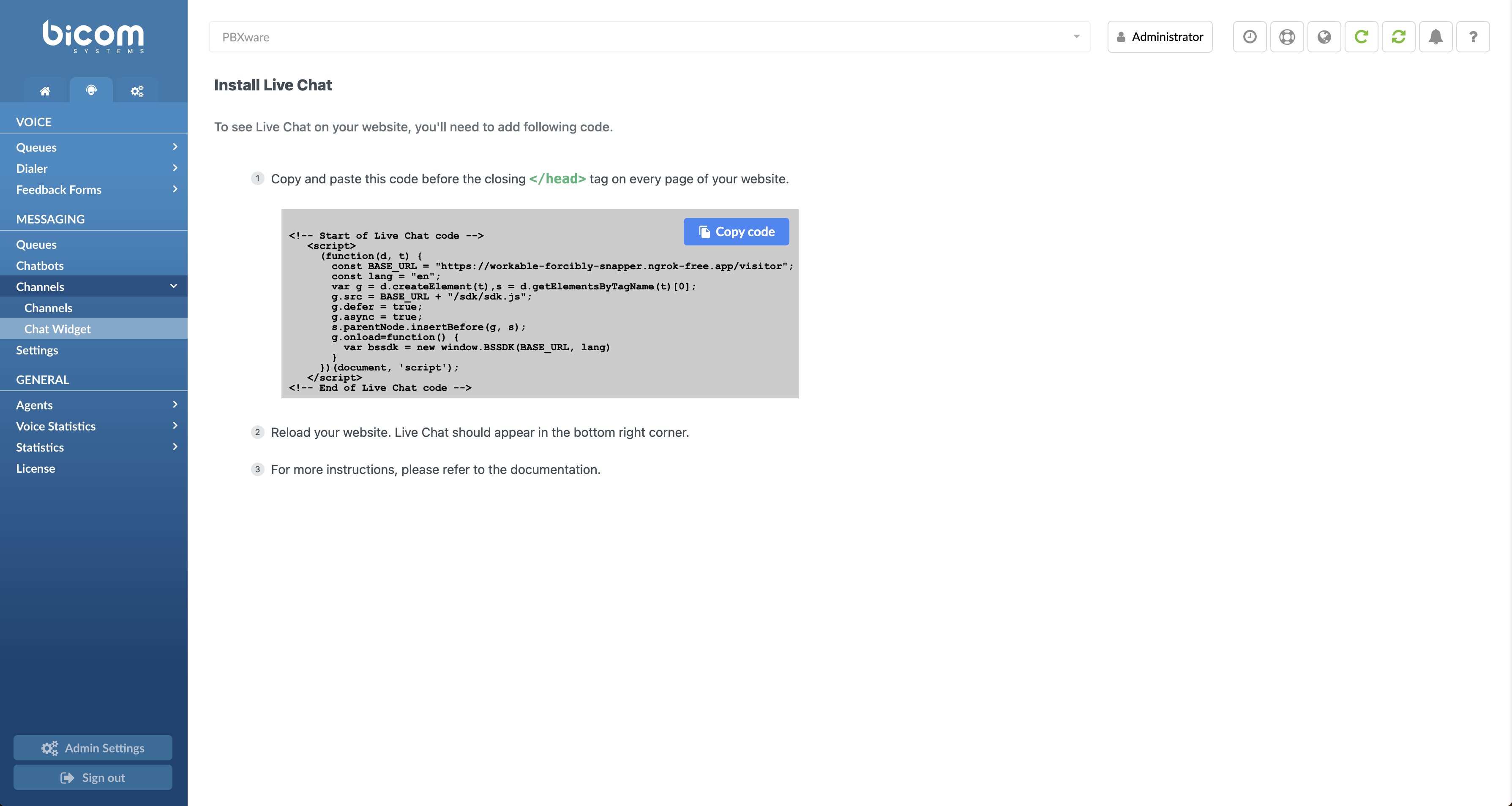¶ Channels
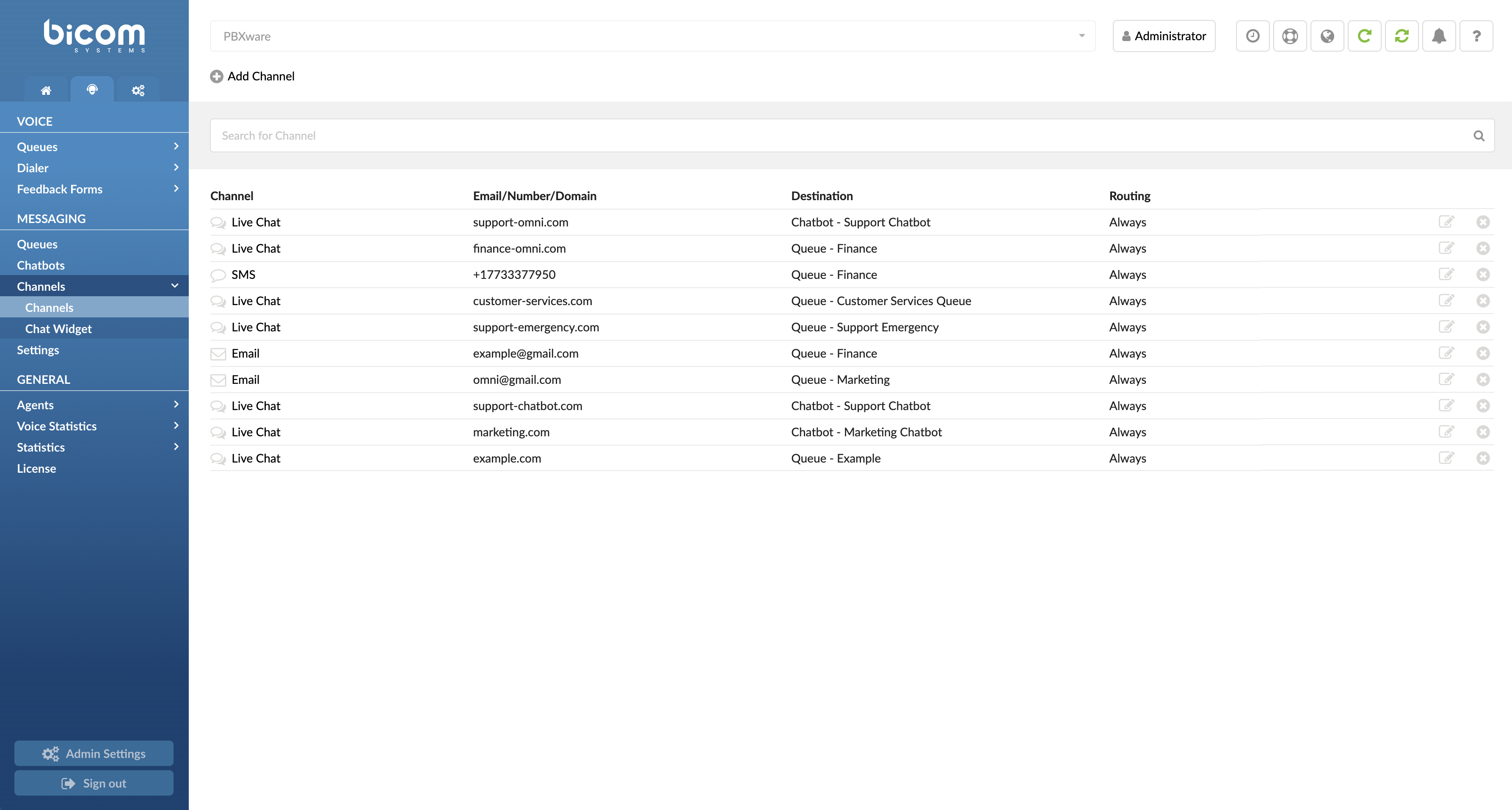
Channels serve as the mediums through which customers can establish communication with Agents. Whether it's through Live Chat, Email, or Messaging, these channels ensure a seamless interaction experience. Channels are more than just pathways; they are strategically designed interfaces that cater to diverse communication preferences of the customers. By offering multiple avenues like Live Chat, Email, and Messaging, we ensure that every customer can reach out in a way that's most convenient for them. This enhancement not only bolsters customer engagement but also streamlines the agent's workflow, making it easier for them to manage and respond to customer inquiries across various platforms.
The Channels landing page section is divided into six columns, each of which provides important information about the channels you have set up.

- Channel
The first column is the Type of Channel, which can be a Live Chat, SMS, Email, Facebook and WhatsApp.
- Endpoint
The second column shows the specific email, phone number or domain that the channel is associated with.
- Destination
The third column is the Destination, which allows you to choose where the channel will be routed. You can select either a Queue or a Chatbot to receive and manage the incoming messages.
- Edit

Clicking this button allows users to edit the configuration settings of the Channel, such as its Name, Domain, Destination for Live Chat or Number for SMS.

- Delete

This button enables users to remove the Channel from the system. When clicked, a confirmation prompt may appear, asking for confirmation before permanently deleting the Channel.

NOTE Please note that if you attempt to remove or delete an email channel that has been added as the email for the Leave a Message Form, a warning message will appear listing the queues that have that email set. You will not be able to delete this channel until you change the email for the Leave a Message Form.
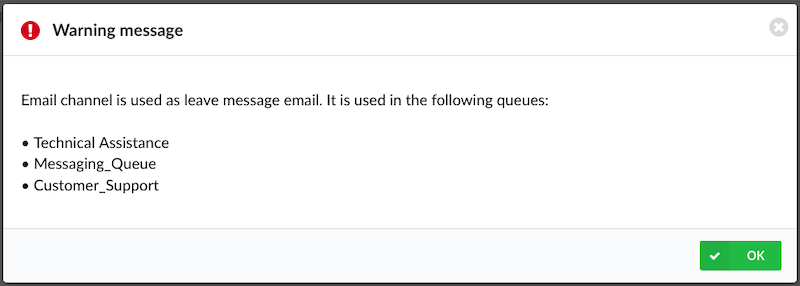
In summary, the Channels section of the Omnichannel software provides a user-friendly and efficient way to manage and organize the different communication channels that your customers use to reach out to your business. It helps to streamline and simplify the process of receiving and handling customer messages, ensuring that all customer inquiries are promptly and effectively addressed.
¶ Live Chat Channel
A Live Chat Channel page is a section of a messaging platform where administrators can set up a live chat channel for their website. The page allows them to specify a domain name that will be used for the chat, choose a queue where the chat will be directed, and select pre-chat and leave-a-message forms that customers will fill out before or after chatting with a support agent. This page enables administrators to customize the live chat experience for their customers and streamline the process of handling customer queries and support requests.
¶ Accessing the Channel Section
- Locate the Channels Section: The Channels section is found under the MESSAGING section of the Contact Centre Module. Once you click on "Channels", you'll be directed to a page that displays a list of available channels.
- Initiate Channel Creation: Click on the "Add Channel" button to bring up the channel creation dialog.
¶ Choosing the Channel Type
-
View Options: Once the dialog is open, you'll see options for creating different channels.
-
Make Your Choice: For this guide, let's select "Live Chat" as the channel type.

- Proceed: Click "OK" to finalize your selection and proceed with the channel setup.

¶ Setting Up Your Live Chat Channel
After selecting Live Chat as your channel type, you'll be guided to the Channel Settings page. Here, you can fine-tune various options:
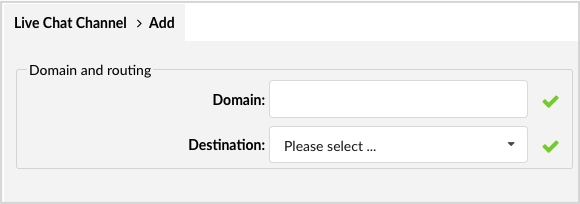
¶ Domain Configuration
- Domain: Specify the domain where your Live Chat will be operational. Once set, this domain will be where the Live Chat runs after users copy a code snippet provided in the Chat Widget section. This is the platform or website where customers can access the Live Chat feature.
¶ Destination Selection
- Destination: The 'Destination' determines how incoming Live Chat requests are handled, either routing them through a Chatbot for further options or directing them straight to a specific Queue. This choice influences the initial interaction path for customers.
(Example: Selecting a 'Sales' queue as the destination ensures that customers using Live Chat on your site are directly connected to sales representatives. On the other hand, choosing a Chatbot can provide customers with multiple options, such as Sales, Support, or Information, allowing them to choose the most relevant department for their needs.)
¶ Pre-Chat Form
Users can choose to enable or disable the pre-chat form for LiveChat conversations. If enabled, customers using the Visitor app will be prompted to enter their name and email address before starting a conversation. If disabled, customers can initiate conversations anonymously without providing any personal information.

¶ Saving Your Settings
- Review: Double-check all settings to make sure they align with your requirements.
- Save: Click the "Save" or "Submit" button to finalize and activate your Live Chat channel.
¶ Setting up your SMS Channel
The SMS Channel page is your gateway to setting up a dedicated phone number for customer messages. These messages are routed to a pre-defined destination like a Queue or Chatbot. You can also customize automated responses, making customer-business SMS communication efficient and streamlined.
¶ Adding an SMS Channel
¶ Accessing the Channel Section
- Go to the Channels under MESSAGGING section.
- Hit the "Add Channel" button to bring up the channel creation dialog.
¶ Choosing the SMS Channel Type
- The dialog will display options for Live Chat, SMS, or Email.


- Pick "SMS" for the channel type.

- Press "OK" to move forward.
¶ Configuring SMS Channel Settings
After selecting SMS, you'll land on the SMS Channel settings page. Here's what you can set up:

-
SMS Number: Input a valid SMS number for sending and receiving messages. Ensure the number is formatted correctly and linked to an active SMS service.
-
Destination: Decide where to route the SMS messages. Options include specific Queues or Chatbots. Choose based on your workflow and how you want to interact with customers.
¶ Saving the Channel
- Double-check the SMS number and destination settings.
- Click either "Save" or "Submit" to finalize the SMS channel setup.
By following these steps, you'll be able to effortlessly integrate SMS as an additional customer engagement channel within your system.
If the same number is configured for both DID and Omnichannel, the system will always prioritize Omnichannel. This means that any incoming messages will be routed to the Omnichannel channel.
¶ Email Channel
The Email Channel page empowers Administrators to set up IMAP and SMTP configurations, designate a Destination Queue for incoming emails, and tweak other settings like attachment size limits or email check intervals. This facilitates the integration of email into your omnichannel system, allowing agents to manage customer emails efficiently.
¶ Adding an Email Channel
¶ Accessing the Channel Section
- Head to the Channels sub-section within the MESSAGGING section.
- Press the "Add Channel" button to initiate the channel creation dialog.
¶ Choosing the Email Channel Type
- In the dialog, opt for "Email" as your channel type.
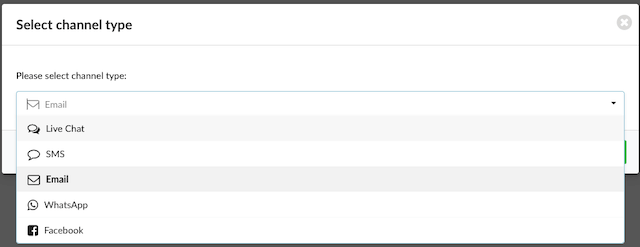
- Hit "OK" to continue.

¶ Configuring Email Channel Settings for Custom Status
When "Custom Server" is chosen from the "Email Provider" dropdown menu within the Email Channel settings window, you'll be presented with detailed configuration options:
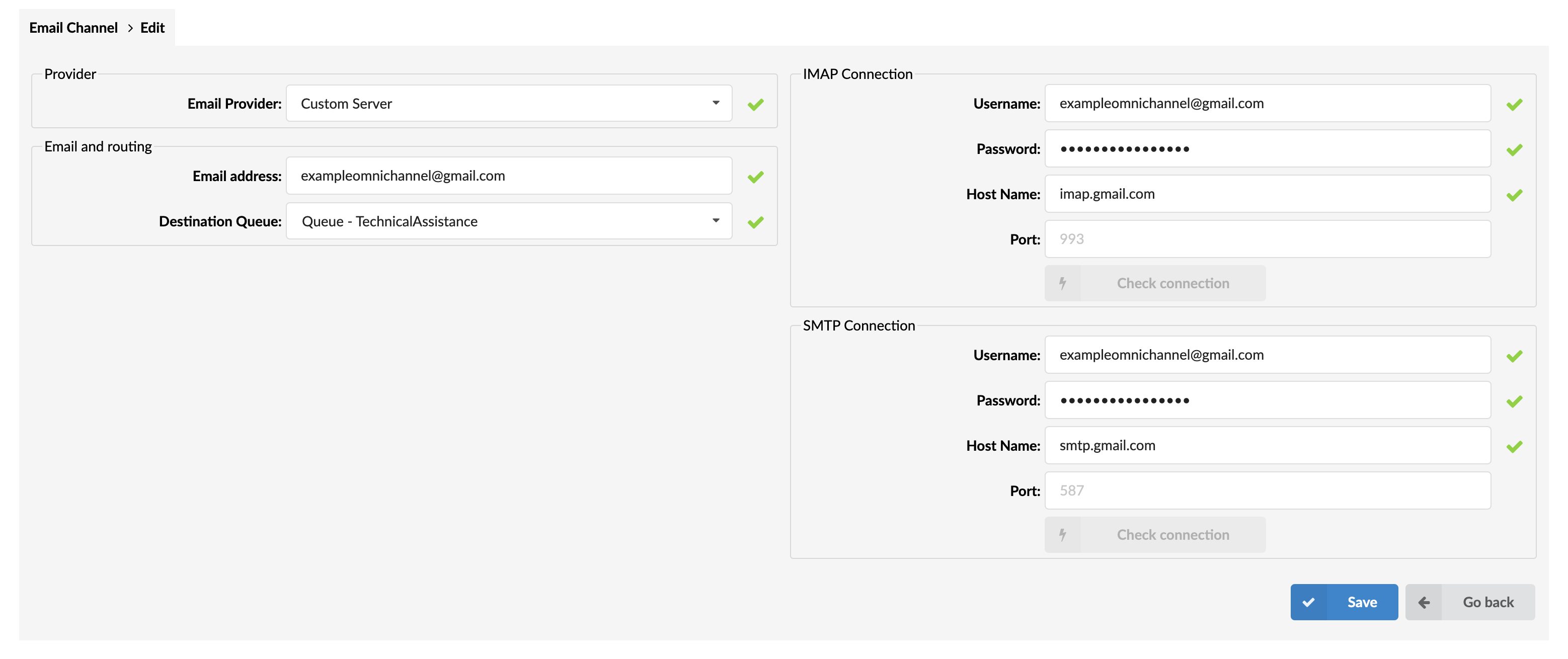
-
Email Address: Input the email address designated for this channel.
-
IMAP Connection:
- Username: Provide the username for IMAP.
(e.g.,exampleomnichannel@gmail.com) - Password: Input the password for IMAP.
- Host Name: Specify the IMAP server host name.
(e.g.,imap.gmail.com) - Port: Define the port for the IMAP server.
(e.g,993)
- Username: Provide the username for IMAP.
-
SMTP Connection:
- Username: Input the username for SMTP.
(e.g.,exampleomnichannel@gmail.com) - Password: Input the password for SMTP.
- Host Name: Specify the SMTP server host name.
(e.g.,smtp.gmail.com) - Port: Define the port for the SMTP server.
(e.g.,587)
- Username: Input the username for SMTP.
- Fill out all the required fields, referencing the example images if necessary.
- From the "Destination Queue" dropdown menu, select the Queue where you want the emails to be directed.
- After setting up both the SMTP and IMAP connections, click "Save" and utilize the "Check Connection" buttons to validate if the IMAP and SMTP connections are functioning correctly.
¶ Saving the Channel
- Ensure all settings are accurately configured.
- Click "Save" to finalize your Email channel settings.
- After saving the settings, you can verify both IMAP and SMTP by clicking on "Check connection" for each.
By following these guidelines, you'll be able to efficiently integrate email as a customer engagement channel, ensuring emails are directed to the chosen Queue for proficient handling.
¶ Configuring Email Channel Settings for Microsoft Integration
Upon selecting "Microsoft" from the "Email Provider" dropdown menu within the Email Channel settings window, the interface adapts to facilitate a streamlined integration with Microsoft services:
- Microsoft SignOn Button: This button will become visible. Clicking on it initiates the Microsoft authentication process.
- Microsoft Login Window: After clicking the "Microsoft SignOn" button, you'll be directed to a Microsoft login page. Input your Microsoft credentials to proceed.
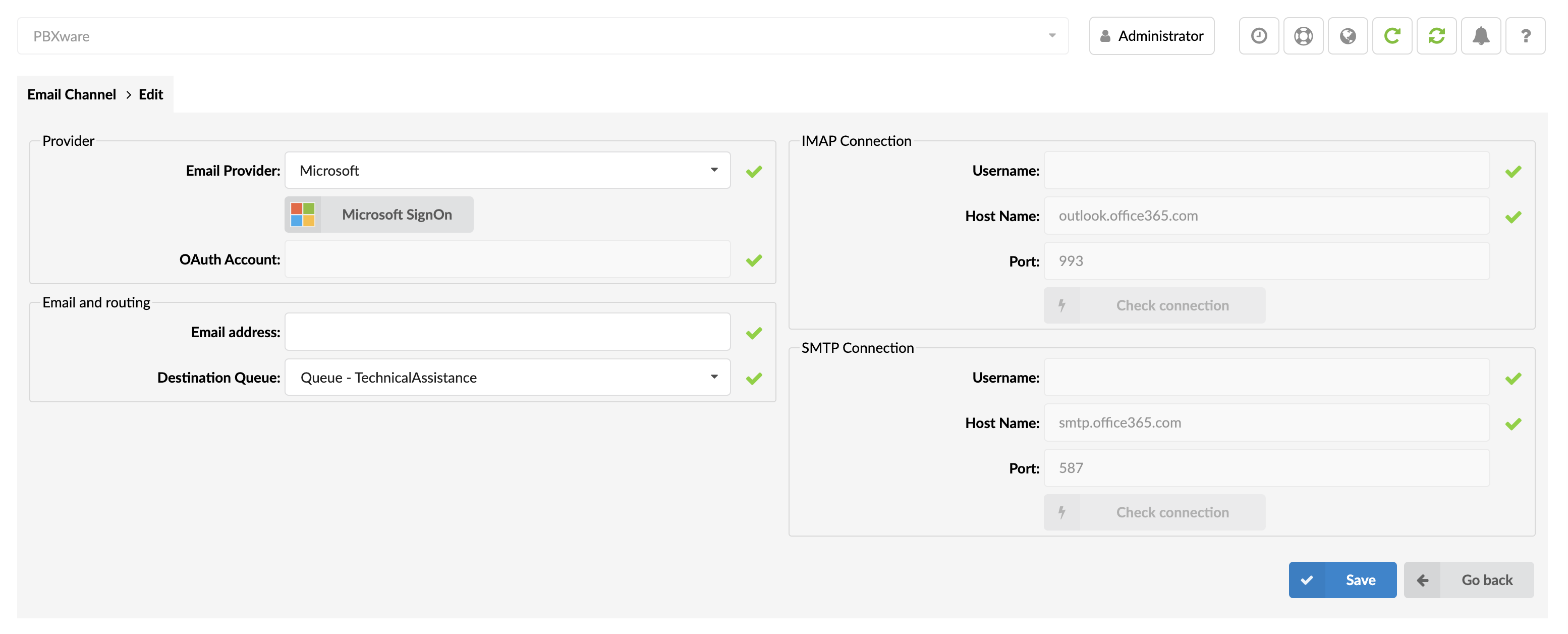
- Permission Authorization: Once logged in, a subsequent window will appear, listing the required permissions that PBXware needs to access your Microsoft account. It's crucial to review and grant these permissions by clicking "Accept" or a similar confirmation button. This step ensures seamless email integration between PBXware and Microsoft.
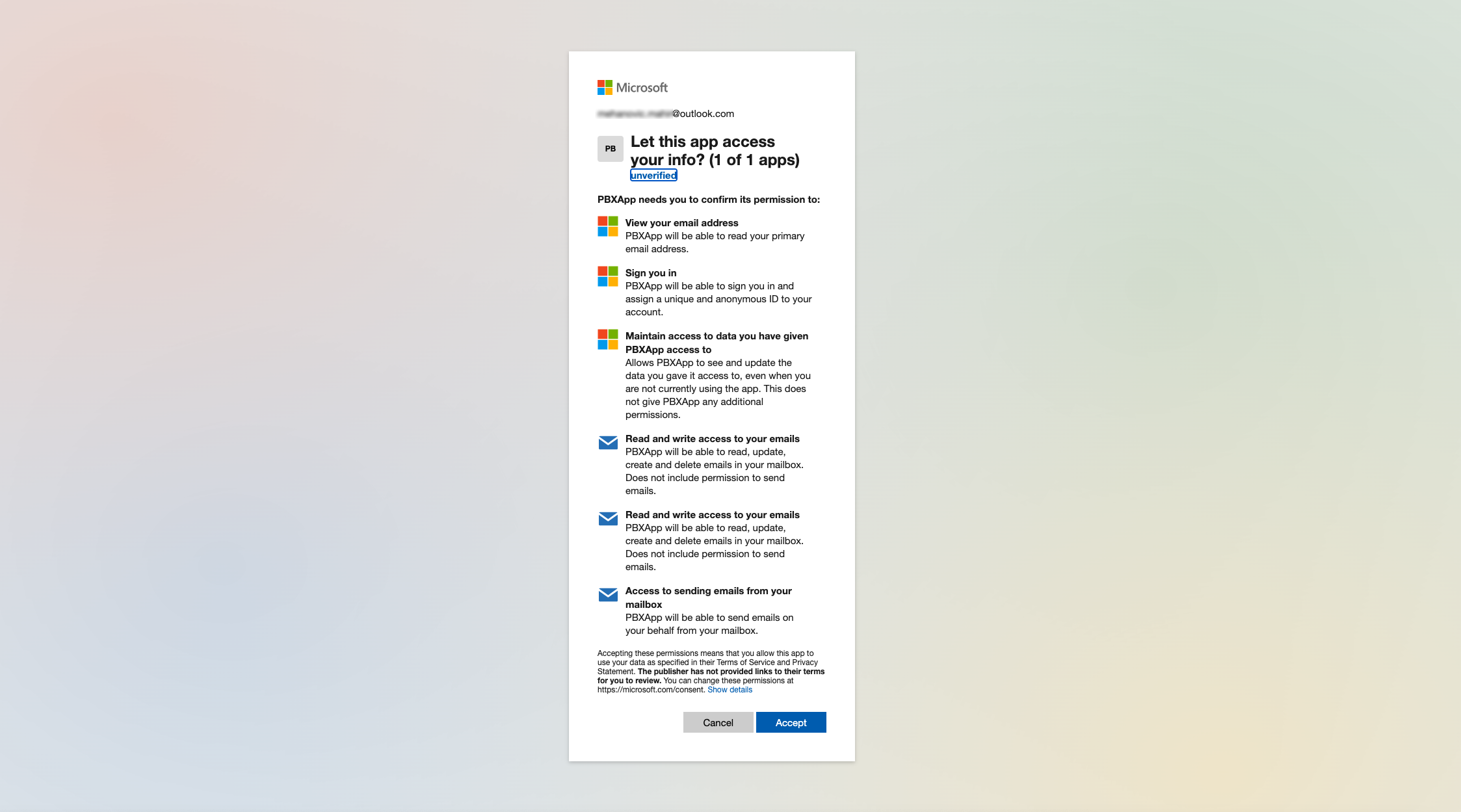
- Automatic Field Population: Post-authentication, the need to manually input password details on the PBXware side becomes redundant. Fields related to email configuration (like SMTP and IMAP) will automatically be populated based on your Microsoft account settings.
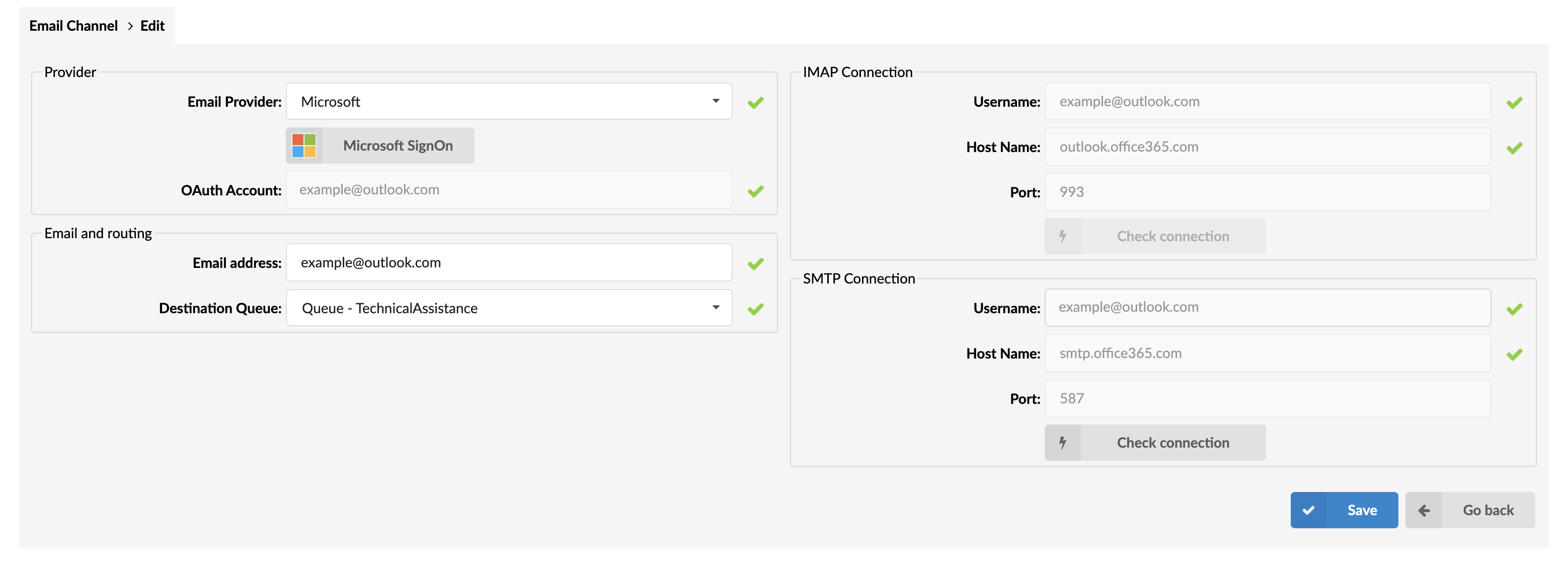
- From the "Destination Queue" dropdown menu, opt for the Queue to which you'd like emails to be routed.
¶ Saving the Channel
- Double-check the auto-populated settings for any discrepancies.
- Click on "Save" to finalize your Email channel setup with Microsoft integration.
- After saving the settings, you can verify both IMAP and SMTP by clicking on "Check connection" for each.
By integrating with Microsoft services in this manner, you can ensure a hassle-free setup, eliminating manual configurations and benefiting from Microsoft's secure authentication processes.
¶ Configuring Email Channel Settings for Gmail Integration
Upon selecting "Gmail" from the "Email Provider" dropdown menu within the Email Channel settings window, the interface will adjust to provide an easy integration with Gmail services:
- Gmail SignOn Button: This button will be prominently displayed. Initiating the Gmail authentication process is as simple as clicking on it.
- Gmail Login Window: After pressing the "Gmail SignOn" button, you will be redirected to a Gmail login page. Here, enter your Gmail credentials to continue.
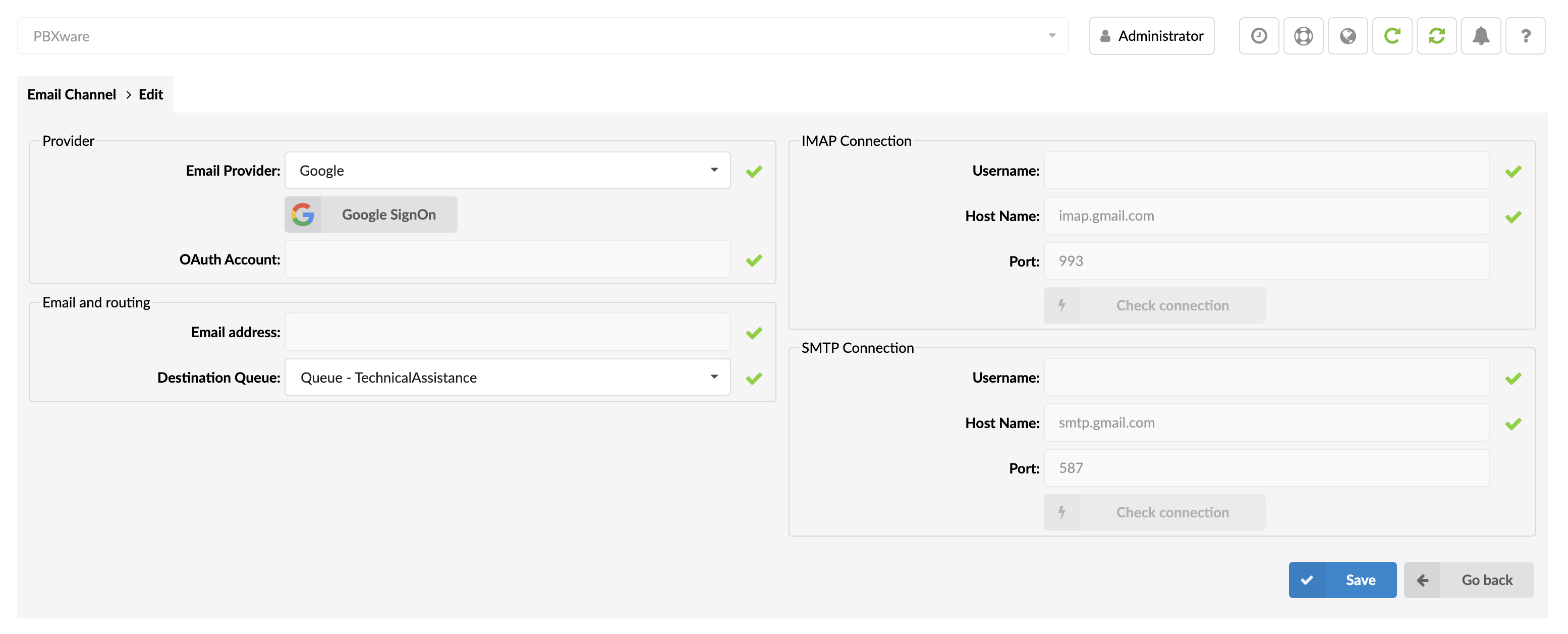
- Permission Authorization: Post-login, a window will pop up, delineating the permissions PBXware requests to access your Gmail account. Carefully review and consent to these permissions by hitting the "Allow" or equivalent confirmation button. This action ensures a smooth email linkage between PBXware and Gmail.
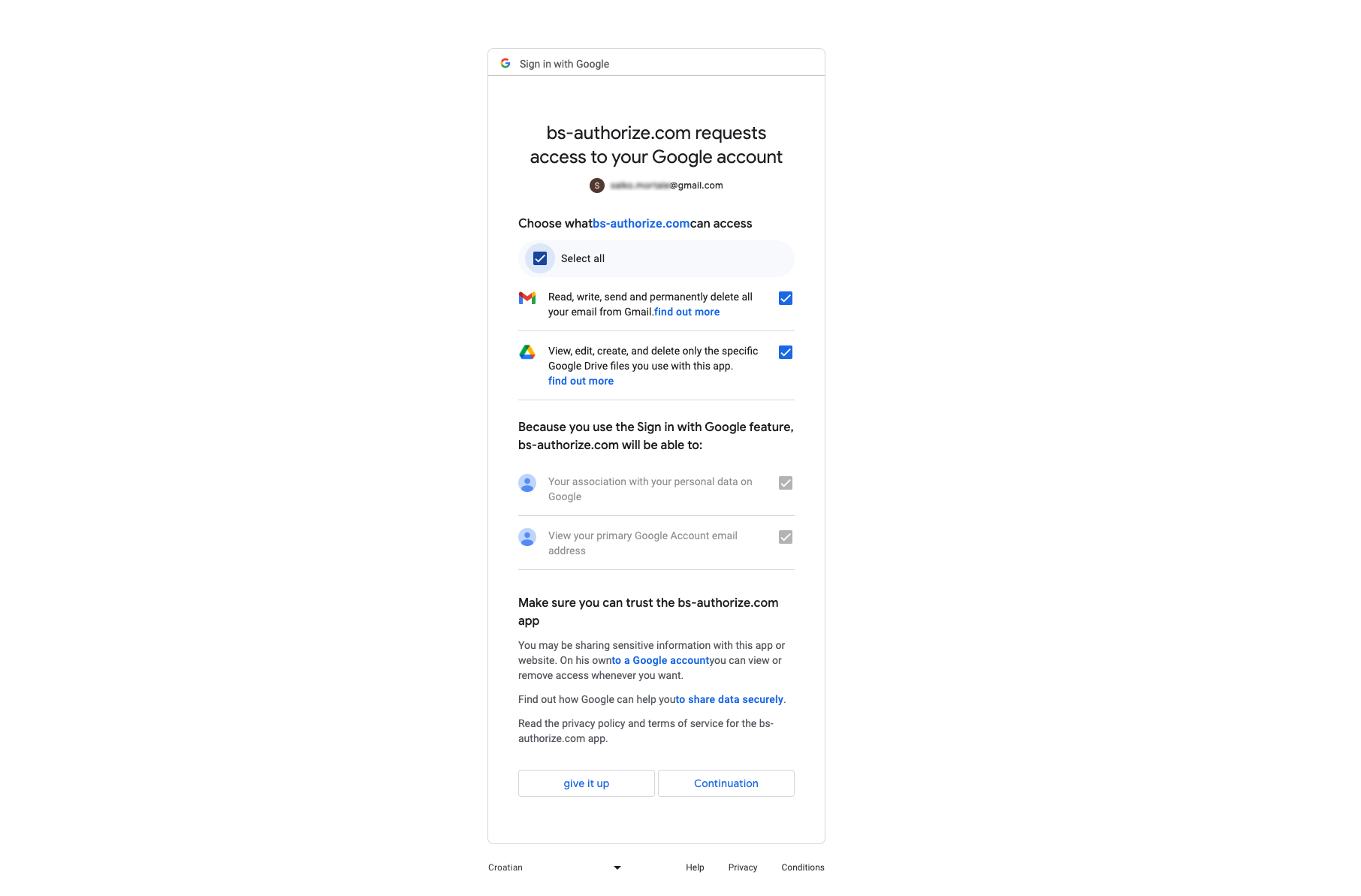
- Automatic Field Population: Once the authentication phase concludes, PBXware will automatically fill out certain fields related to email configuration, removing the need for manual password entry.

- From the "Destination Queue" dropdown menu, select the appropriate Queue for directing emails.
¶ Saving the Channel
- Peruse the automatically populated settings to verify their correctness.
- To confirm your Email channel setup with Gmail integration, tap "Save".
- After saving the settings, you can verify both IMAP and SMTP by clicking on "Check connection" for each.
Through this integration with Gmail, manual configuration steps are significantly curtailed, and you benefit from Gmail's robust and secure authentication mechanism.
¶ How Email Threading Works
¶ What is Email Threading?
Email threading refers to the method of connecting reply emails to the original email or ticket they are responding to. This is crucial in customer support and helpdesk systems to maintain conversation continuity and context. Threading helps organize communication and makes it easier for support agents to track an issue's progress.
¶ How does our system handle it?
For every incoming email, our system checks two markers to understand whether the email is a reply to an existing ticket or a new one that needs to be created. Markers that our system checks for every new incoming email are:
- Ticket ID
- Message-ID
¶ Ticket ID
By default, a ticket ID is generated when a ticket is created on our system. The notifications the customer and agent receive about the ticket updates will carry the ticket ID in the subject line. Our system threads tickets by looking for the ticket ID in the subject line in this format - [#{ticket_id}]; so it is advisable to configure the subject line for your email notifications to carry the Ticket ID in the above format. When the customer or agent replies to these notifications, the system will check if the ticket ID matches and thread the reply accordingly.
In picture one, we can see that the subject when the first email is sent doesn't contain the ticket ID, and in the second, the Ticket ID is added to the subject when the agent replies. In the background, this Ticket ID is added on our system when a new ticket is created.
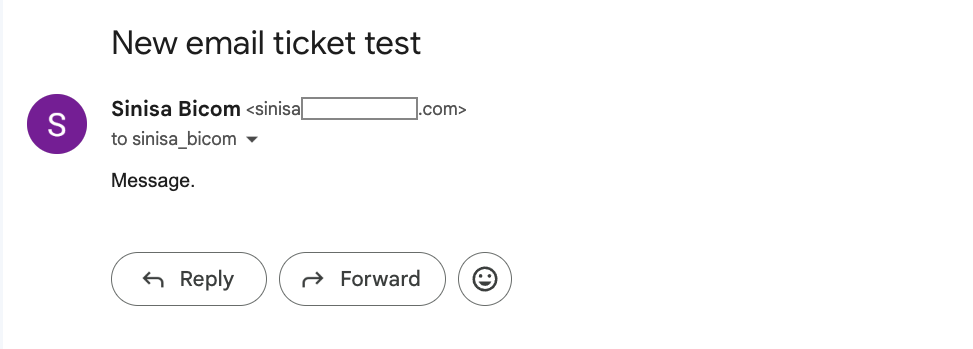
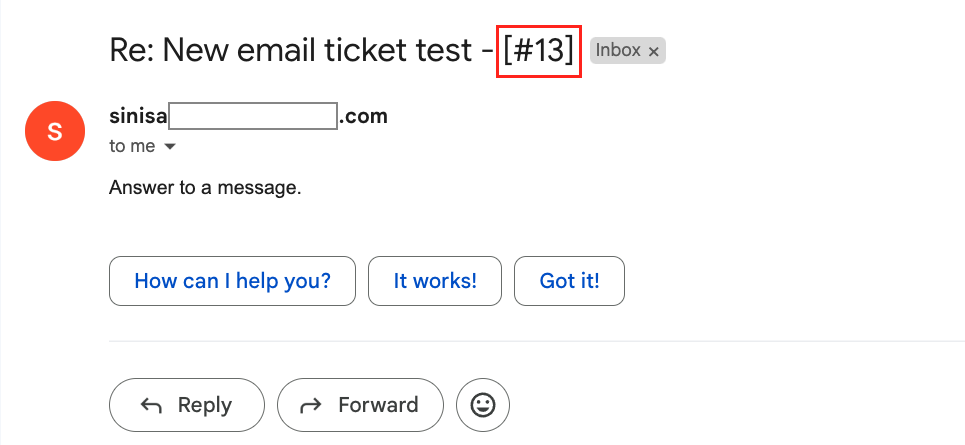
¶ Message-ID
Every email has a unique identifier assigned to it by the email provider called Message-ID.
When you reply to an email, the Message-ID of the original email is included in the 'In-Reply-To' or 'References' section. This Reference ID is used to thread the reply to the original email. Our system uses the same method to thread replies to tickets.
Here is the sample header with References:
Date: Tue, 23 Jul 2024 06:20:48 +0000
Message-ID: SI2PR06M5549EBD803EECF882BB61C3A1A92@SI2PR06MB4554.apcprd06.prod.outlook.com
References: CA+mgTdfxHKfGLmR5E2noXQqo+kcr05WaSEYv4_irFjzam-nA@mail.gmail.com
In-Reply-To: CA+mgTdfxHKfGLmR5E2noXQqo+kcr05WaSEYv4_irFjzam-nA@mail.gmail.com
Accept-Language: en-US
Content-Language: en-IN
X-MS-Has-Attach:
X-MS-Exchange-Organization-SCL: -1
X-MS-TNEF-Correlator:
X-MS-Exchange-Organization-RecordReviewCfmType: 0
Content-Type: multipart/alternative; boundary="000_SI2PR06MB45549EBD803EECF882B1C3A1A92SI2PR06MB4554apcp"
MIME-Version: 1.0
¶ Facebook Channel
The enhancement to Contact Center Edition includes integration with Facebook Messenger! This means businesses can directly communicate with customers on Facebook, tapping into its massive user base for enhanced engagement.
In today’s digital landscape, where consumers are more connected and empowered than ever before, businesses must adopt a holistic approach to engage with their audience across multiple channels.
¶ Integration Requirements
Before proceeding with the integration of Facebook into the Omnichannel setup, ensure that your system meets the following requirements:
System Requirements
- PBXware System
You must have the PBXware system with Contact Center Edition version 7.2 or higher installed. This version is necessary to ensure compatibility with the Facebook integration features.
- gloCOM Client
Ensure that gloCOM, the unified communications client for the PBXware system, is installed on your system with a version of 7.2 or higher. gloCOM provides essential functionalities required for seamless communication across channels.
- License Requirements
Make sure that your PBXware system license includes the following components:
- Agent Edition - Ensure that a sufficient number of agent licenses are enabled to accommodate the expected workload for handling Facebook interactions.
- Supervisors Edition - Enable supervisor licenses to oversee and manage Facebook interactions within the omnichannel setup.
- OmniChannel - The OmniChannel module must be enabled within your license to support the integration of Facebook as a communication channel.
Please be aware when agents or supervisors log in for the first time, they’ll occupy a slot in the omnichannel module. Ensure you have the correct number of omnichannel modules to accommodate your team.
- The COMMSware Messaging Platform (CMP)
A solution designed to function as a proxy between your omnichannel system and meta-information related to messaging interactions.
Integrating the CMP service into your omnichannel architecture enhances the interoperability and versatility of your messaging capabilities. By acting as a dedicated proxy for managing meta- information, the CMP service enables your omnichannel system to focus on core functionalities, such as message processing, routing, and orchestration, without the overhead of dealing with intricate messaging details.
Facebook Integration Requirements
- Facebook Account
Access to an active Facebook account is essential alongside obtaining or creating a Meta developer account when integrating Facebook into the omnichannel system.
Please note that due to Facebook policies targeting fake profiles with false information and images, newly created accounts are at risk of being banned. This may affect your ability to integrate Facebook with Omnichannel services. We recommend using real information when setting up your Facebook account to avoid any issues with integration.
- Meta Business Account
Before you can create a Meta app, it’s necessary to sign up for a Meta business account in Business Manager. To create a Meta business account go to the Business Manager official website.
- Meta Developer Account
Similarly, access to a Meta developer account is necessary to manage the technical aspects of integrating Facebook into the omnichannel.
To begin the process of setting up your Meta developer account go to the facebook developer website and log in with your active facebook account credentials.
- Meta Application
The Meta App is essential for integrating with the Facebook channel. It can be created using your company's developer account, or you (your company) can be added to an existing Meta App. Regardless, the integration process cannot be completed without it.
These components are essential for setting up and using Facebook integration effectively.
Facebook Integration Working Logic
This diagram illustrates the flow of logic for Facebook integration, depicting the path from customer requests (shown by red lines) to agent responses (shown by blue lines).

You can view or download a detailed guide on how to integrate Facebook with your PBXware system by following our link. (https://downloads.bicomsystems.com/guides/omnichannel/facebook_userguide.pdf)
¶ Adding Facebook Channel
-
Locate the Channels Section: To access the Channels section, navigate to the MESSAGING section within the Contact Centre Module. Clicking on "Channels" will lead you to a page where you can view a list of available channels.
-
Initiate Channel Creation: To initiate channel creation, simply click on the "Add Channel" button, which will prompt the channel creation dialog to appear.
-
Channel Options: When the dialog is open, you'll find options for creating a channel for Live Chat, SMS, Email, Facebook, or WhatsApp.
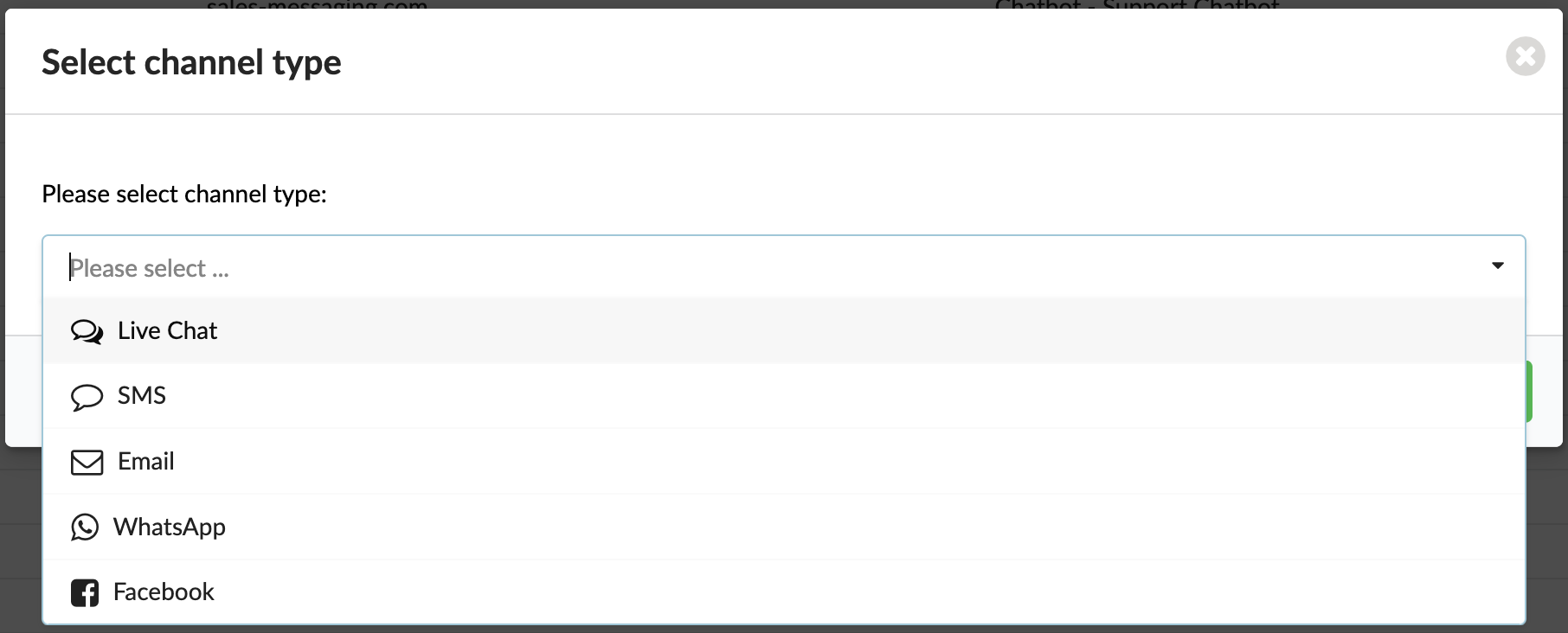
- Channel Type: To begin the process of creating a Facebook channel, select the Facebook channel type.

- Proceed: Confirm your selection by clicking "OK" to finalize it and proceed with the setup of the channel.
¶ Setting Up Your Facebook Channel
After confirming the creation of your facebook channel, you'll be directed to the next window.
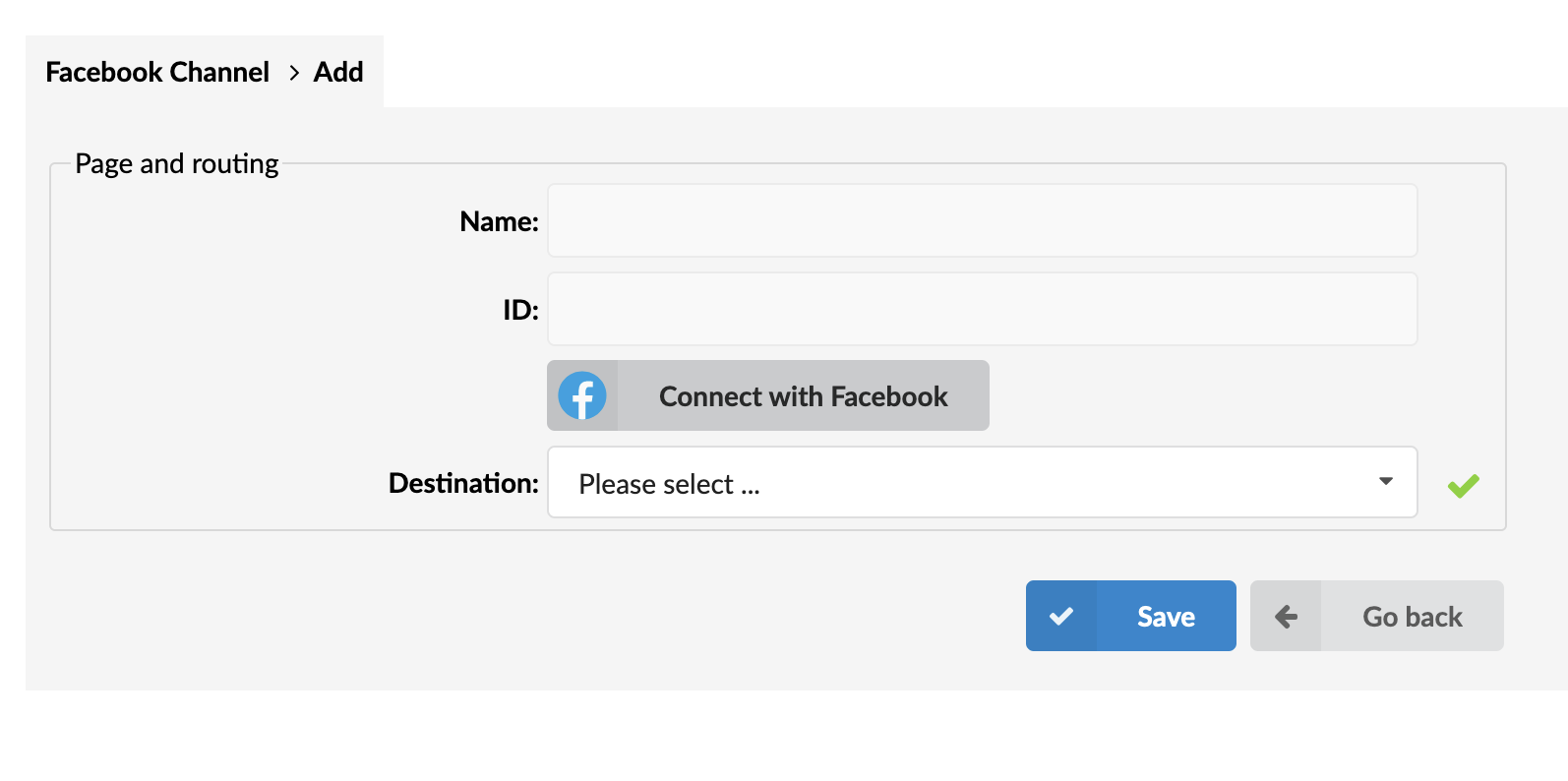
-
Name and ID: The first two options (Name and ID) cannot be edited; they will automatically populate once you connect your Facebook account.
-
Connect with Facebook: The "Connect with Facebook" button allows you to link your Facebook account with the system, enabling integration of the Facebook channel.
-
Destination: The Destination field enables you to select a messaging queue to handle queries received via the Facebook channel.
¶ Setting Up CMP and Connect With Facebook
When you click the "Connect with Facebook" button, a new CMP window will appear, prompting you to connect via your Facebook account.
Simply continue by clicking the "Login with Facebook" button on this window.
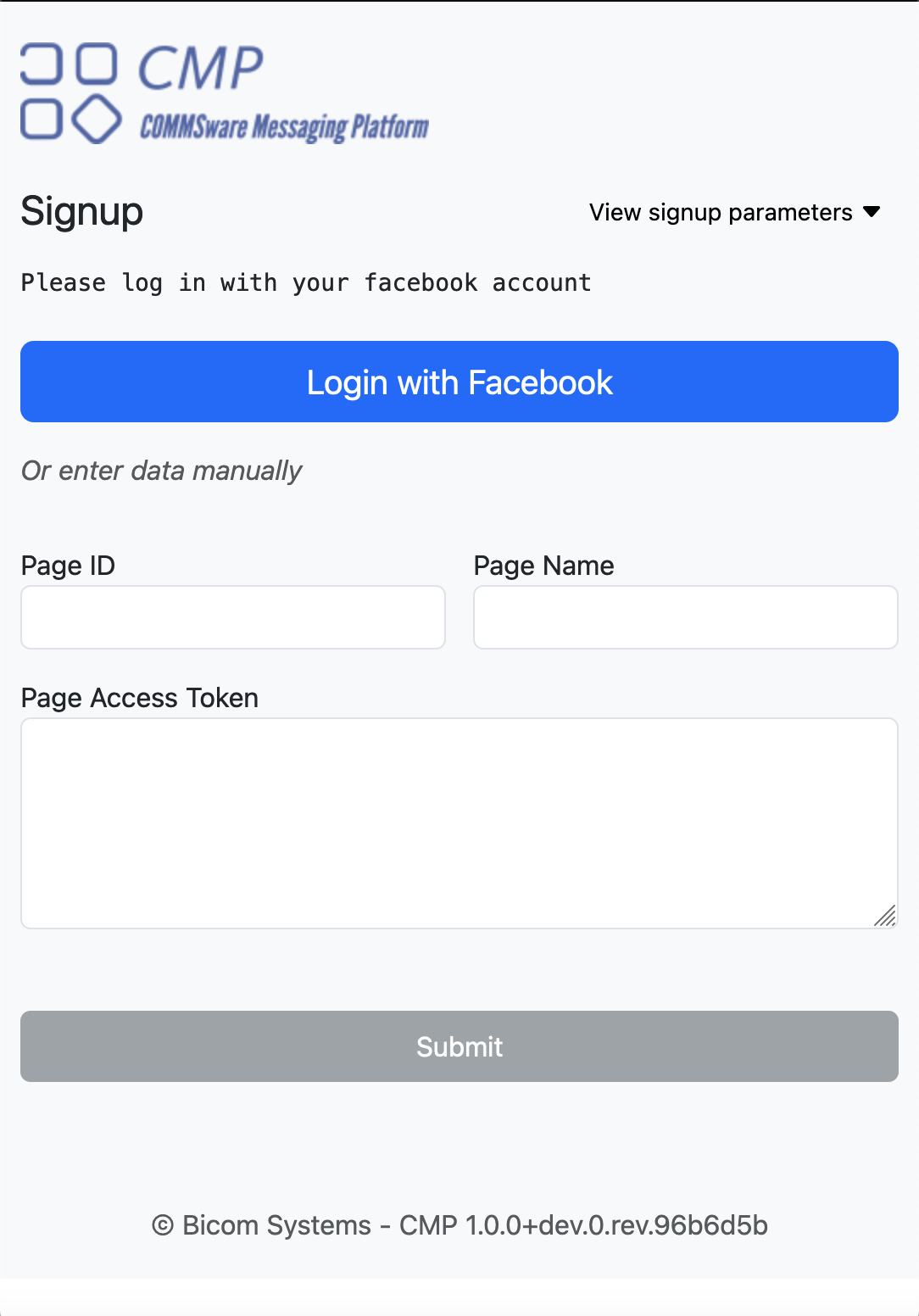
There's no need to manually add information such as 'Page ID', 'Page Name', or 'Page Access Token', as these fields will be automatically populated once you connect with your Facebook account.
You’ll encounter a new window where you’ll need to log in with your Facebook account.
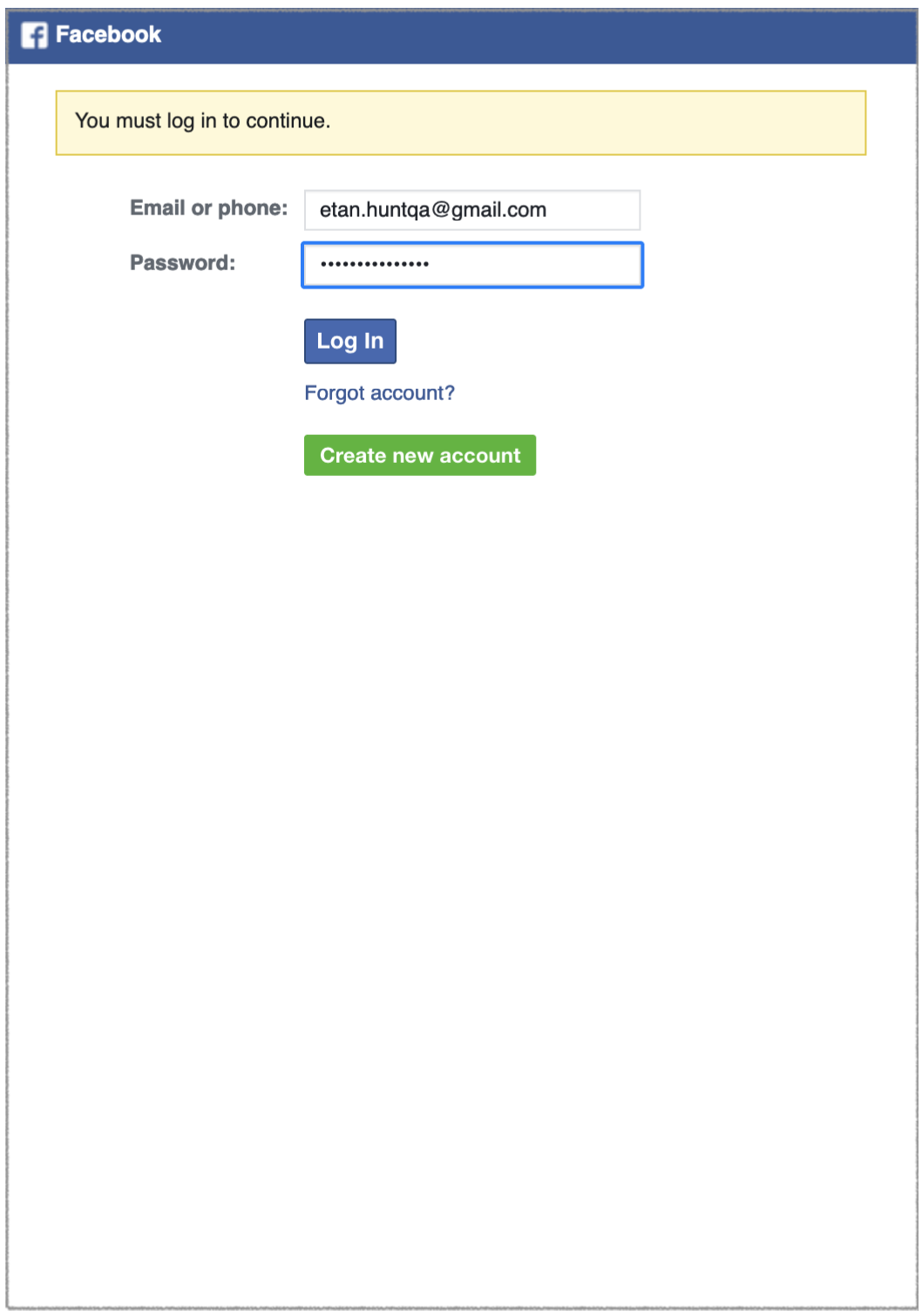
Once logged in, the next window will prompt you to link your Facebook account with the Meta project you were previously added to. Click on "Continue" to proceed:

Next, you’ll be asked to add the page or pages that the Meta project(app) will have access to. Select the relevant pages and click on "Continue" to proceed:
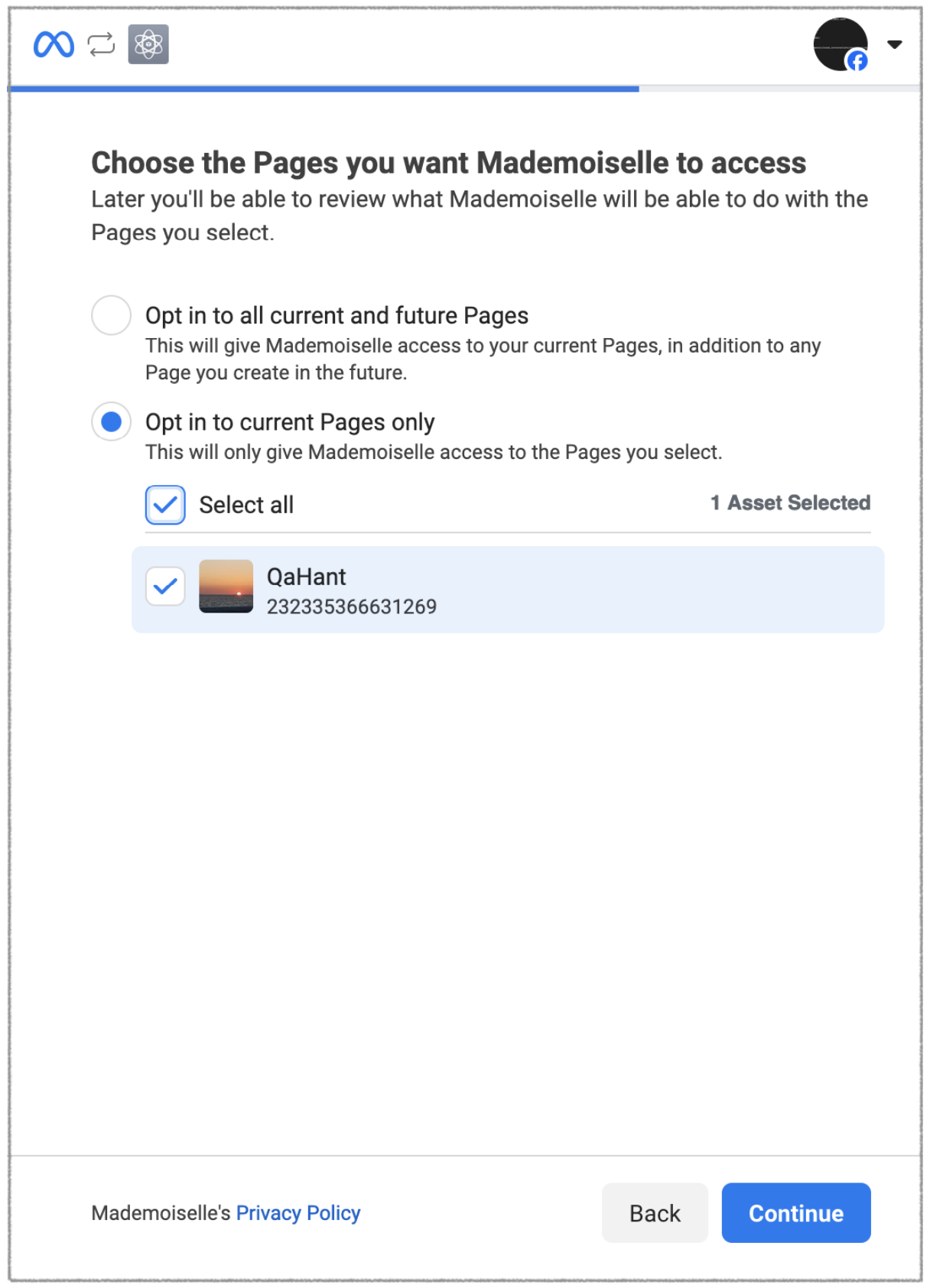
To access meta projects, you'll need to either create a Meta app using your meta developer account or be added by an admin to a previously created Meta project. In either case, having a meta developer account is essential. Please refer to the requirements necessary for integrating with Facebook.
After adding the pages, you’ll be presented with a brief review of the Meta access. Review the information carefully and ensure it aligns with your intentions:
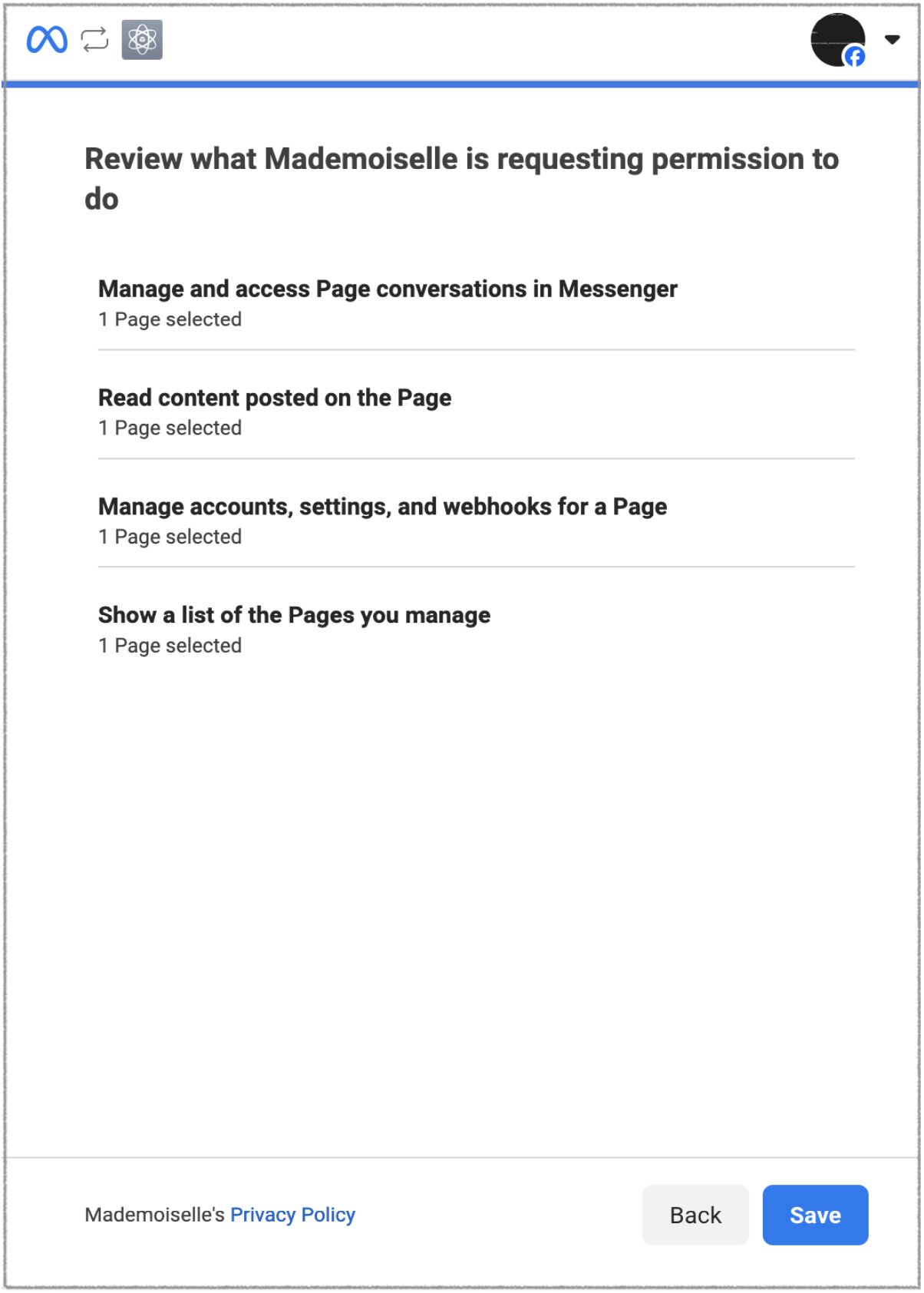
Once you’ve confirmed the details, save and proceed to the CMP window to continue with the setup process.
After a successful connection with your Facebook account, the fields within the new window will be automatically populated. At the end of the setup, the CMP window should resemble the following image:
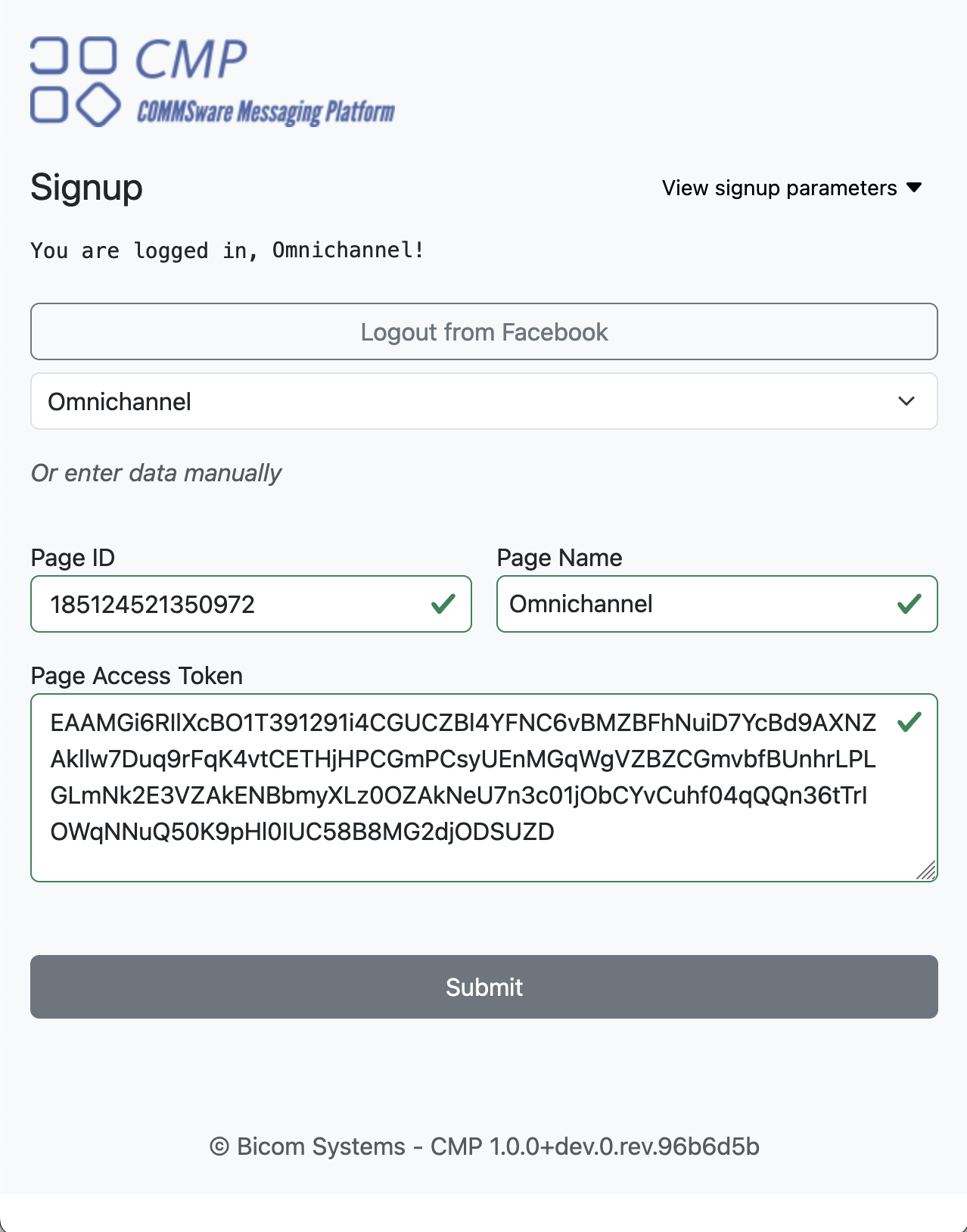
After clicking the "Submit" button, you'll be redirected back to the PBX GUI. From there, you'll need to select the destination queue for integrating the Facebook channel.
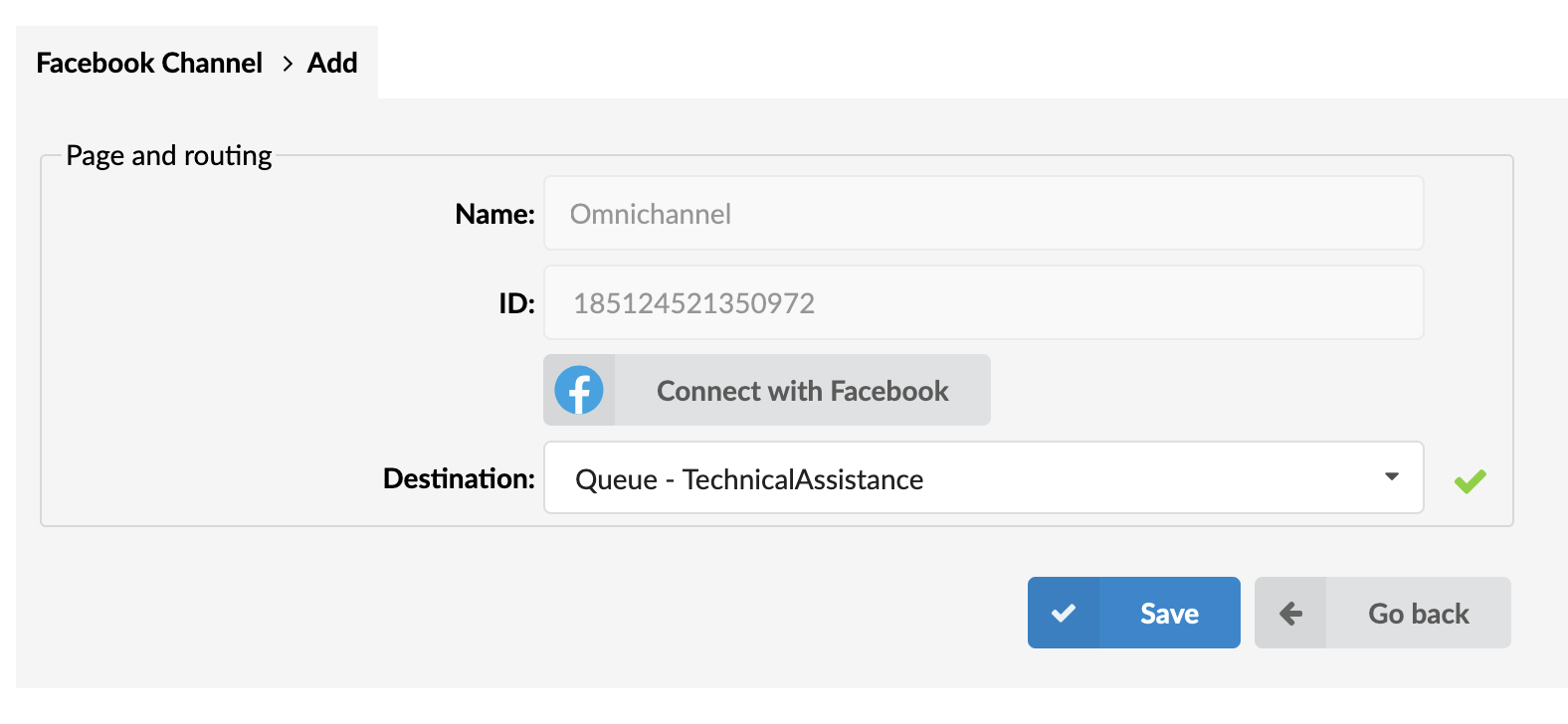
The first two fields will be automatically filled in (required).

To confirm the creation of the Facebook channel, click on the "Save" button.
¶ WhatsApp Channel
With the latest update to Contact Center Edition, users can now integrate WhatsApp! This means businesses can connect with customers on WhatsApp, making communication easier and more convenient for everyone.
¶ Integration Requirements
Before proceeding with the integration of WhatsApp into the Omnichannel setup, ensure that your system meets the following requirements:
System Requirements
- PBXware System
You must have the PBXware system with Contact Center Edition version 7.2 or higher installed. This version is necessary to ensure compatibility with the Facebook integration features.
- gloCOM Client
Ensure that gloCOM, the unified communications client for the PBXware system, is installed on your system with a version of 7.2 or higher. gloCOM provides essential functionalities required for seamless communication across channels.
- License Requirements
Make sure that your PBXware system license includes the following components:
- Agent Edition - Ensure that a sufficient number of agent licenses are enabled to accommodate the expected workload for handling Facebook interactions.
- Supervisors Edition - Enable supervisor licenses to oversee and manage Facebook interactions within the omnichannel setup.
- OmniChannel - The OmniChannel module must be enabled within your license to support the integration of Facebook as a communication channel.
Please be aware when agents or supervisors log in for the first time, they’ll occupy a slot in the omnichannel module. Ensure you have the correct number of omnichannel modules to accommodate your team.
- The COMMSware Messaging Platform (CMP)
The COMMSware Messaging Platform (CMP) service is a bespoke solution designed to function as a proxy between your omnichannel system and meta-information related to messaging interactions.
The CMP service is a vital intermediary component within your omnichannel architecture, facilitating seamless communication and data exchange between the omnichannel system and various messaging platforms. It acts as a bridge, allowing your omnichannel system to efficiently manage and process messaging interactions while abstracting the complexities of handling meta-information associated with these interactions.
WhatsApp Integration Requirements
To successfully integrate WhatsApp into your omnichannel strategy, you’ll need to ensure you have the following prerequisites:
- Phone Number
To be eligible for registration, business phone numbers must meet the following criteria:
• Owned by you
• Have a country and area code (shortcodes are not supported)
• Able to receive voice calls or SMS (You will receive an SMS message or a call to verify the registration of the number.)
- Facebook Account with a Business Manager
An active Facebook account with a business manager is essential for WhatsApp integration.
By fulfilling the requirements of accessing your Facebook and Business Facebook Page, you’ll be well-equipped to integrate WhatsApp into the omnichannel and enhance customer engagement across channels.
- 360Dialog WhatsApp Partner Account
Creating a WhatsApp Partner Account involves communication with a third party, such as 360Dialog, who will provide all necessary information. They’ll guide you through the process including requirements, documentation, and specific steps needed to create your WABA.
For more information and guidance on obtaining a 360Dialog account, please contact our Account Managers.
WhatsApp Integration Working Logic
This diagram illustrates the logic flow for WhatsApp integration, highlighting the path from customer requests (indicated by red lines) to agent responses (indicated by blue lines).

You can view or download a detailed guide on how to integrate WhatsApp with your PBXware system by following our link. (https://downloads.bicomsystems.com/guides/omnichannel/whatsapp_userguide.pdf)
¶ Adding WhatsApp Channel
-
Locate the Channels Section: To access the Channels section, navigate to the MESSAGING section within the Contact Centre Module. Clicking on "Channels" will lead you to a page where you can view a list of available channels.
-
Initiate Channel Creation: To initiate channel creation, simply click on the "Add Channel" button, which will prompt the channel creation dialog to appear.
-
Channel Options: When the dialog is open, you'll find options for creating a channel for Live Chat, SMS, Email, Facebook, or WhatsApp.

- Channel Type: To begin the process of creating a WhatsApp channel, select the WhatsApp channel type.
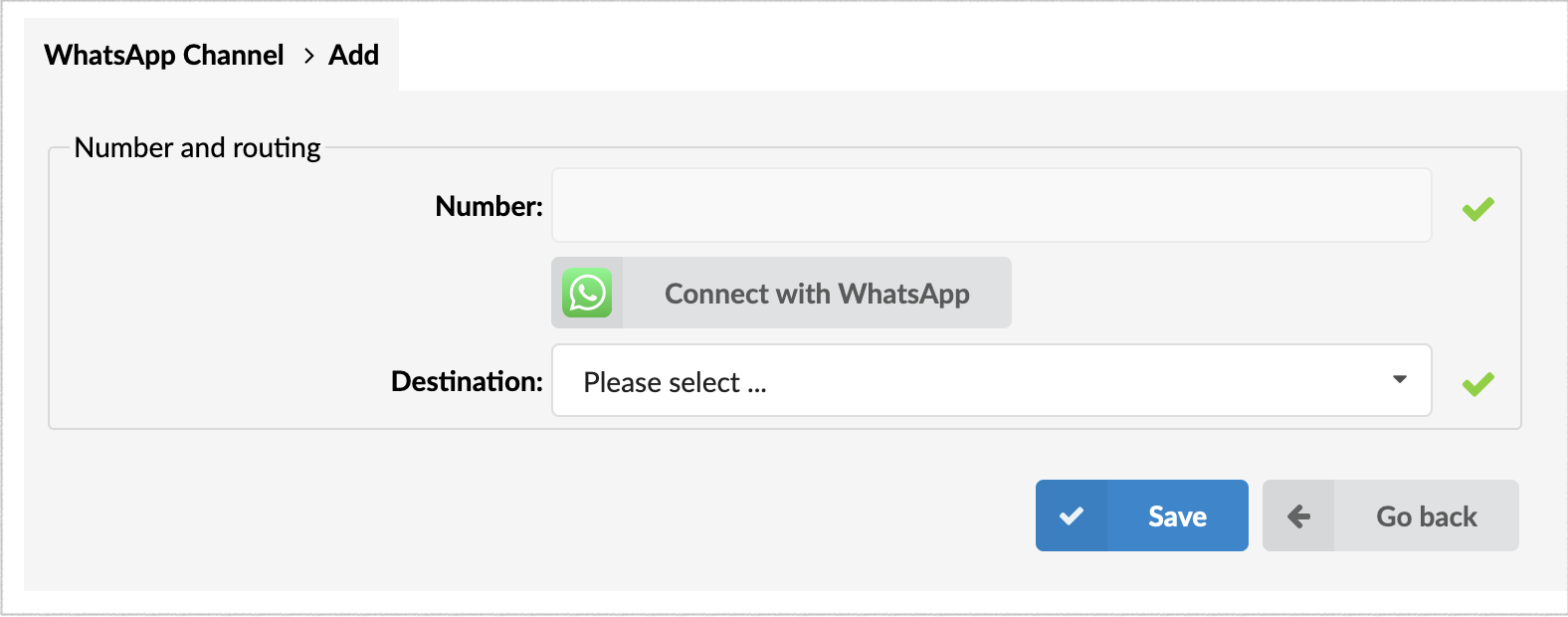
- Proceed: Confirm your selection by clicking "OK" to finalize it and proceed with the setup of the channel.
¶ Setting Up Your WhatsApp Channel
After confirming the creation of your WhatsApp channel, you'll be directed to the next window.
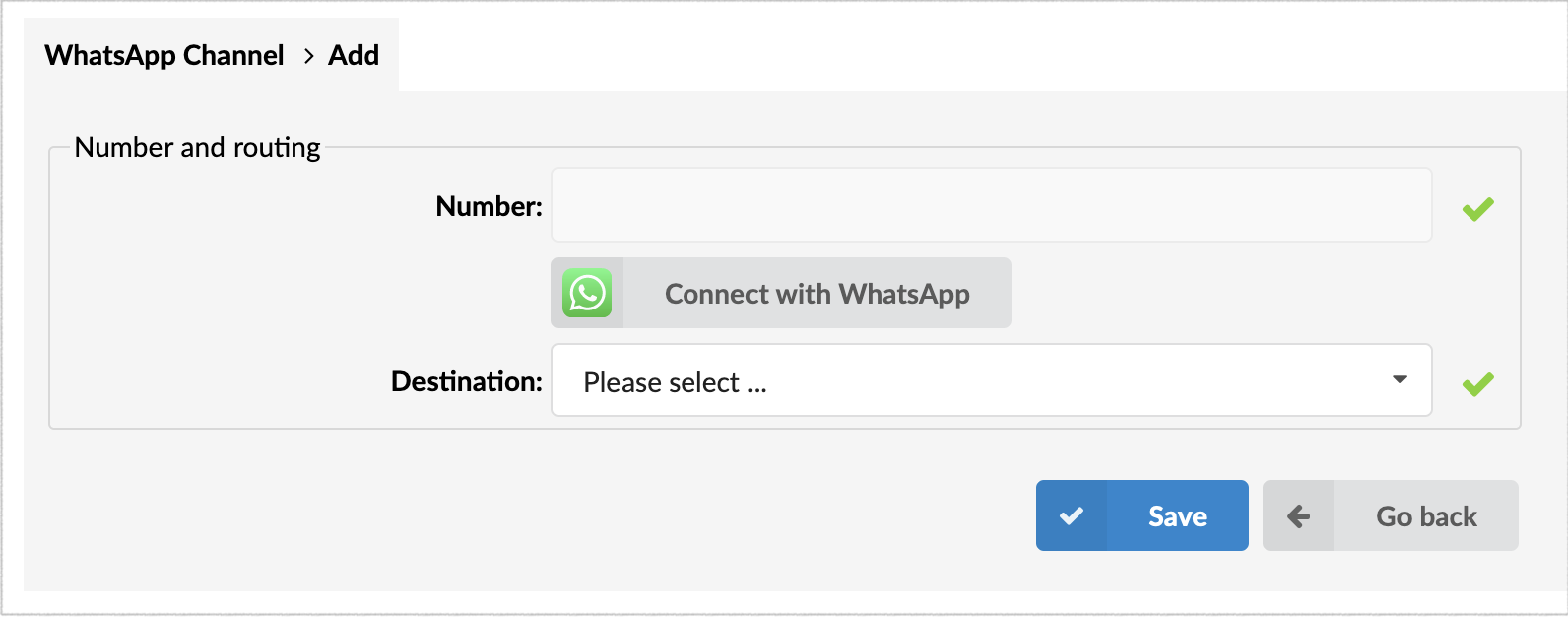
-
Number: The first 'Number' option cannot be edited, as it will automatically populate once you connect your WhatsApp account.
-
Connect with WhatsApp: The "Connect with WhatsApp" button allows you to link your WhatsApp account with the system, enabling integration of the WhatsApp channel.
-
Destination: The Destination field enables you to select a messaging queue to handle queries received via the WhatsApp channel.
When you click the "Connect with WhatsApp" button, a new CMP window will appear, prompting you to connect via your WhatsApp account.
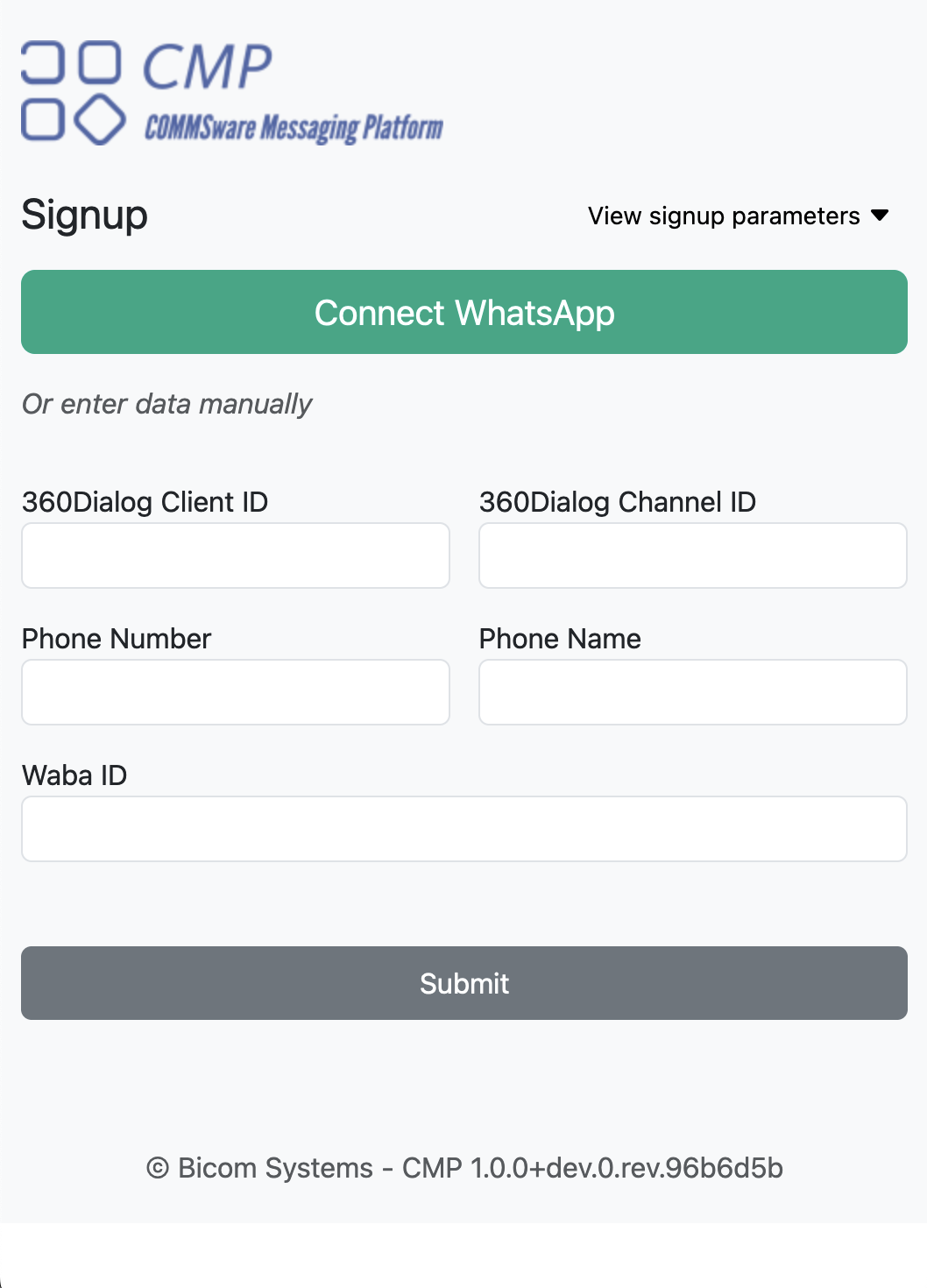
There's no need to manually add information such as '360Dialog Client ID', '360DialogChannel ID', 'Phone Number', etc., as these fields will be automatically populated once you connect with your WhatsApp account.
Proceed by clicking on the "Connect with WhatsApp" button. Afterwards, you will be redirected to the 360 dialog page, where you need to create your account or log in if you already have a 360 dialog account.
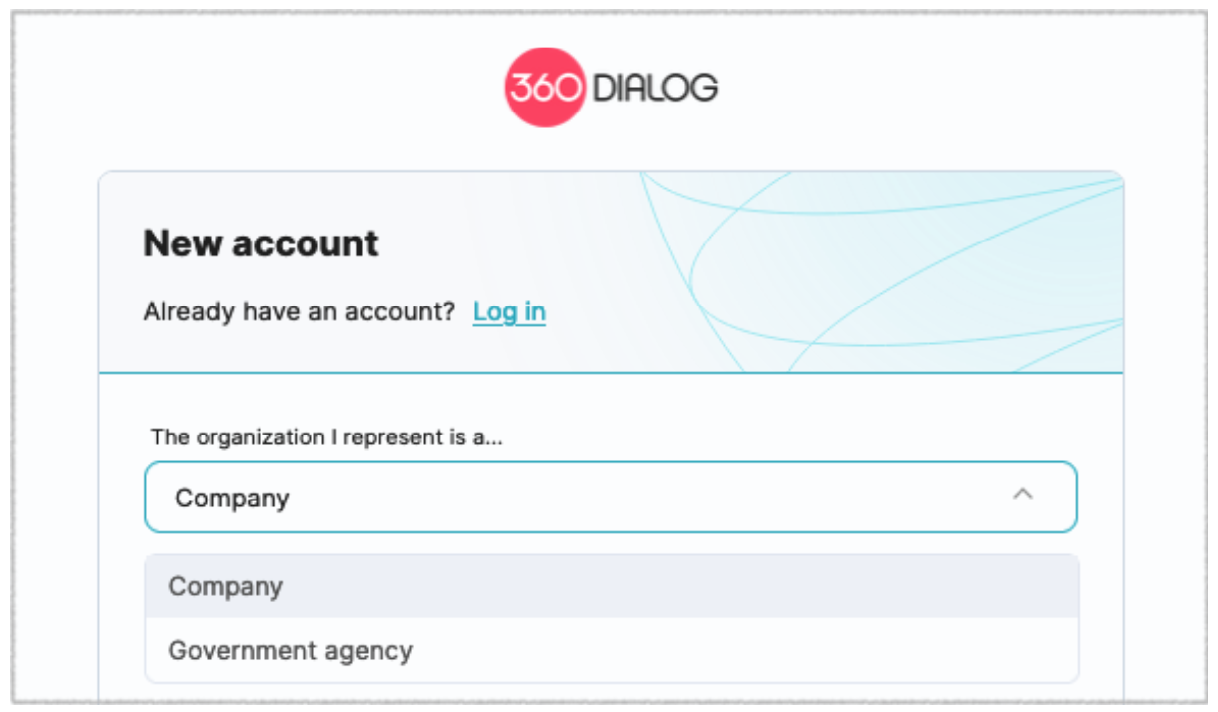
You can begin by indicating whether your organization is classified as a company or a government agency.
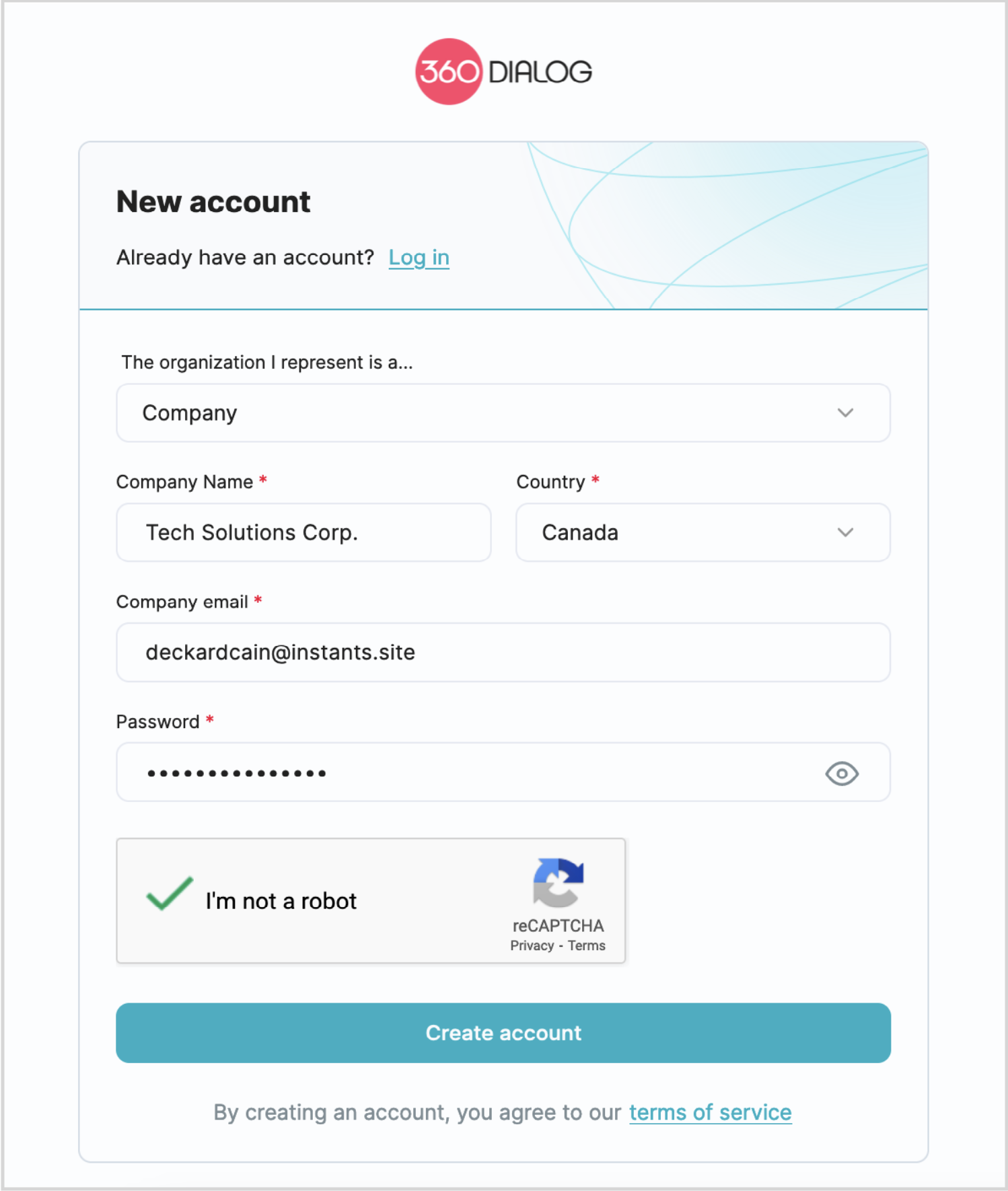
Enter your company’s name and choose your country from the provided options. Add your company’s email address and provide a secure password for your account. This will serve as your login credentials for accessing the 360 Dialog platform.
Before proceeding, take a moment to read through the Terms of Service. It’s essential to understand the terms and conditions governing the usage of the 360 Dialog platform. After reviewing the Terms of Service, click the option to create your account.
Due to Meta’s policies regarding the creation of Governmental Agency accounts, we will not cover that use case since Governmental Agency companies must get approval before creating WhatsApp Business accounts.
On the following window, you will be asked to verify your email via a one-time passcode.
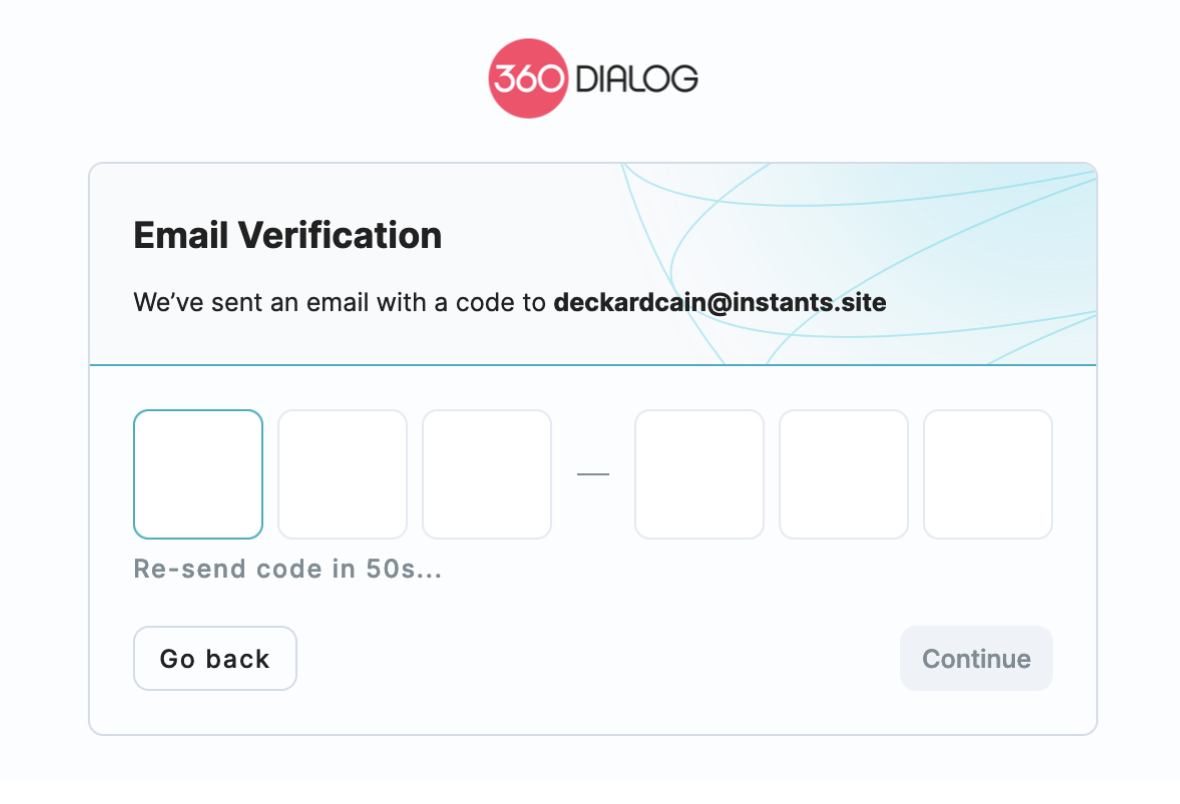
Completing the account creation process will send a verification code to your email address. Check your email for the code, enter it into the provided field, and when you’re ready, click the "Continue" button.
Once you’ve successfully submitted your code and your email is verified, you can proceed to start the WhatsApp registration process on the next window.
On the window presented, you’ll need to confirm the status of your phone number.
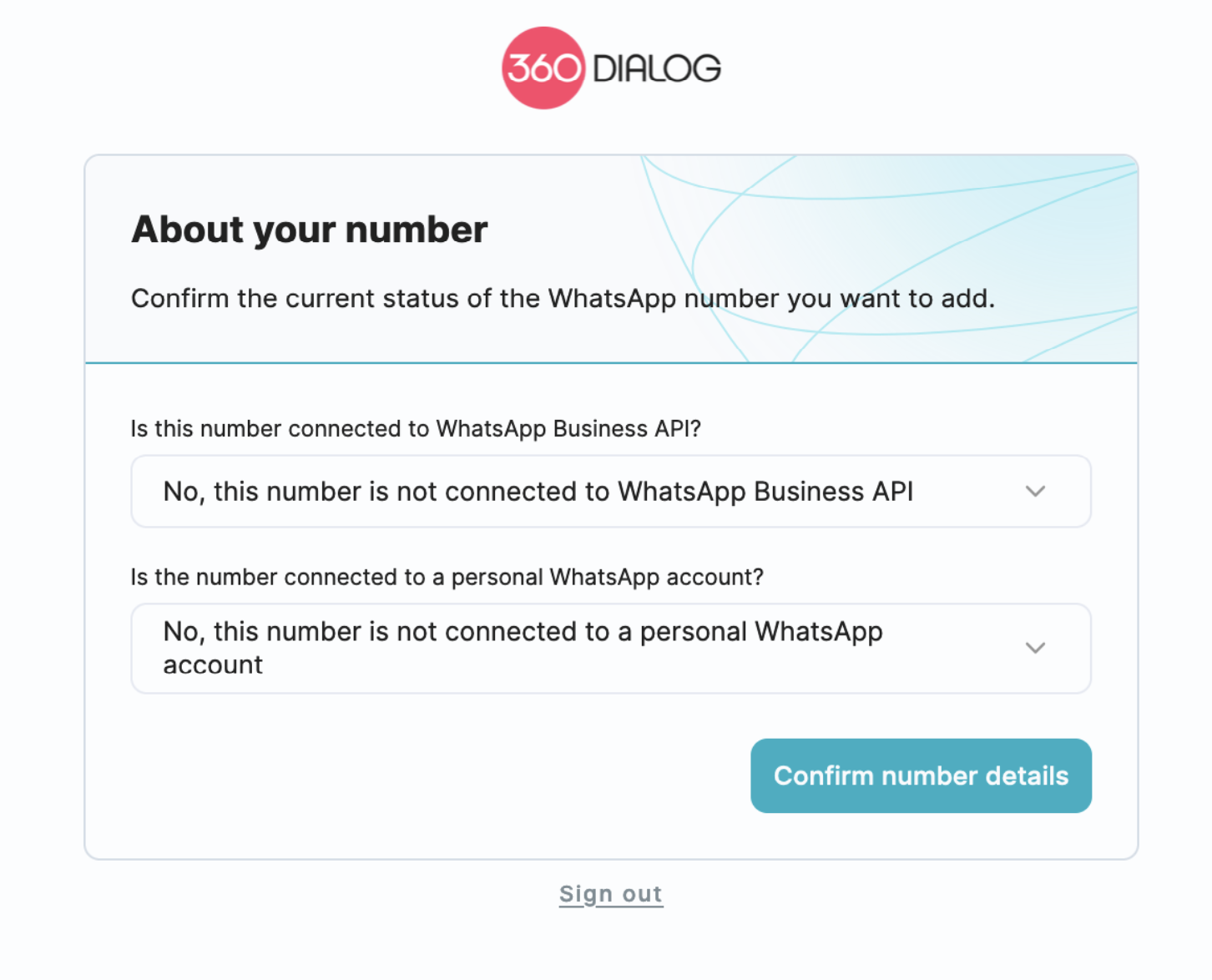
Indicate whether your number is connected to the WhatsApp Business API or if it is associated with a personal WhatsApp account.
Click the Confirm number details button, to proceed with the integration process. This action will confirm the status of your phone number and allow you to continue with the setup.
As we proceed, we’ll now initiate the embedded signing process. This involves accessing your Meta account, selecting or creating a new WhatsApp business account, and assigning a phone number to your account.
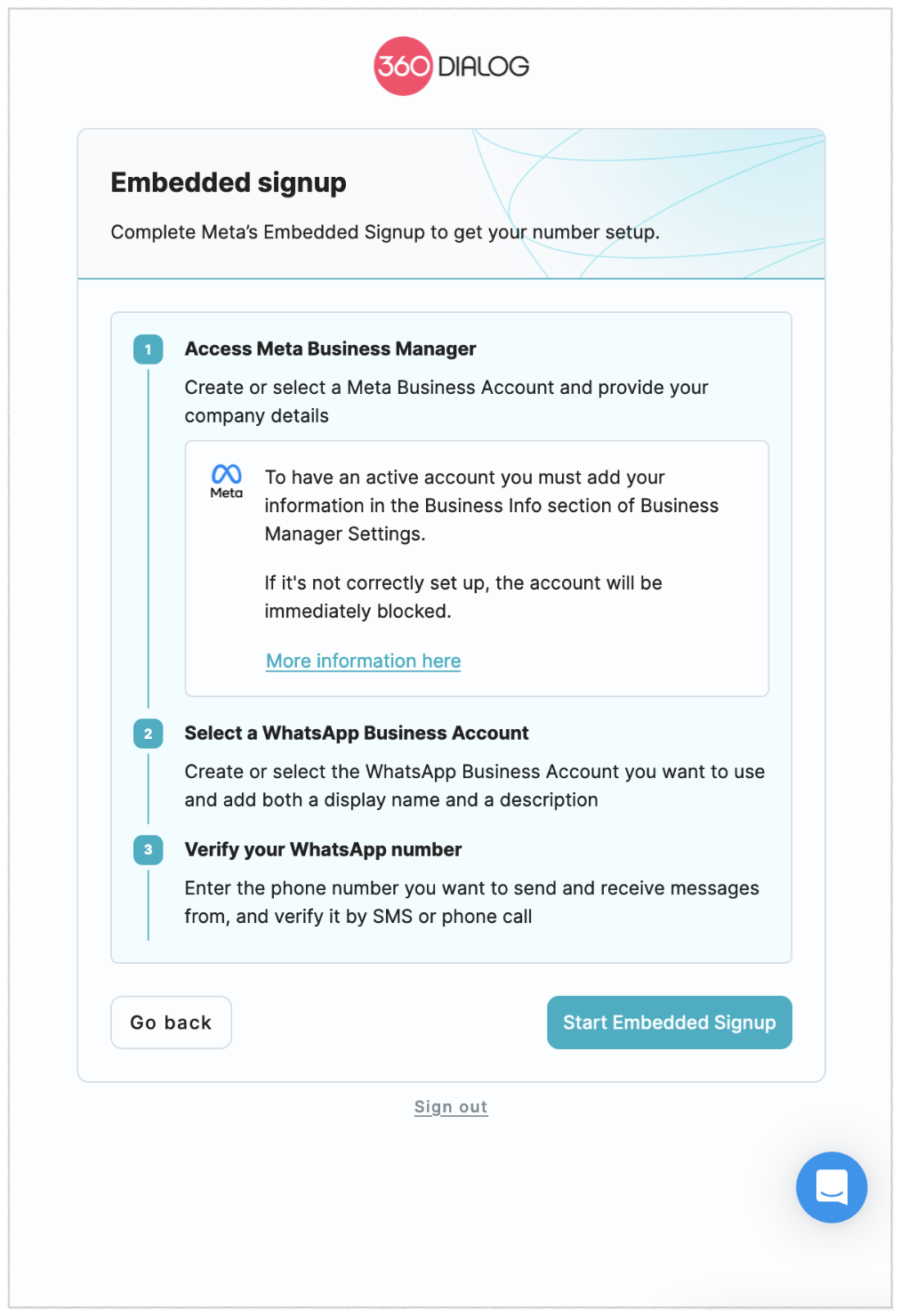
Proceed by clicking on the Start Embedded Signing button. Afterwards, you will be asked to log in with Facebook, or if you are already logged in, simply continue as a Facebook user.
Now, you need to connect your account to 360Dialog, where you will provide your business information to set up your WhatsApp business profile.
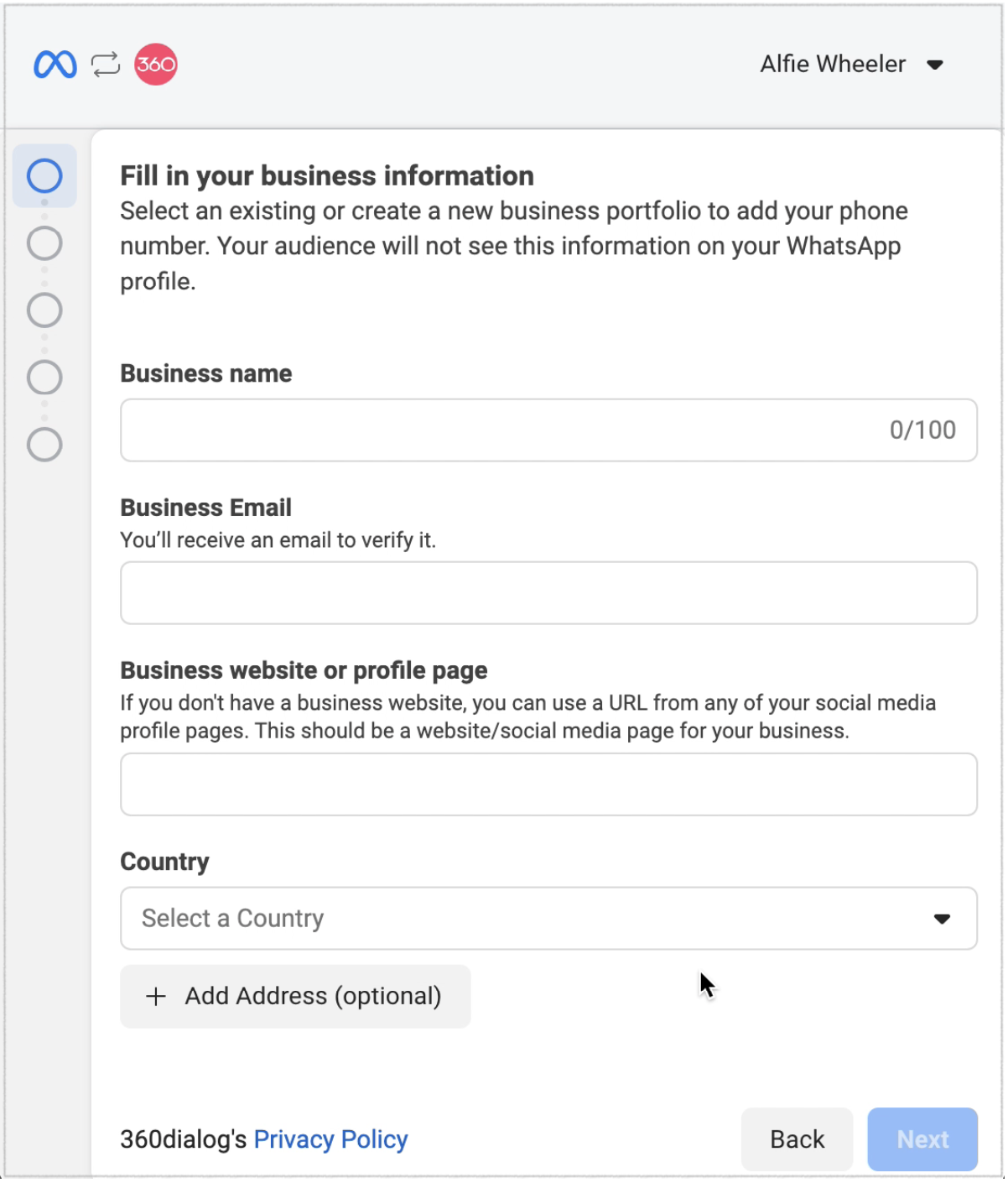
You can add your business name, business email, and company’s public website here. Please ensure that the website is accessible to the public.
In the following window, you will be prompted to create a new business account or select an existing one. To proceed with the setup click the Next button.
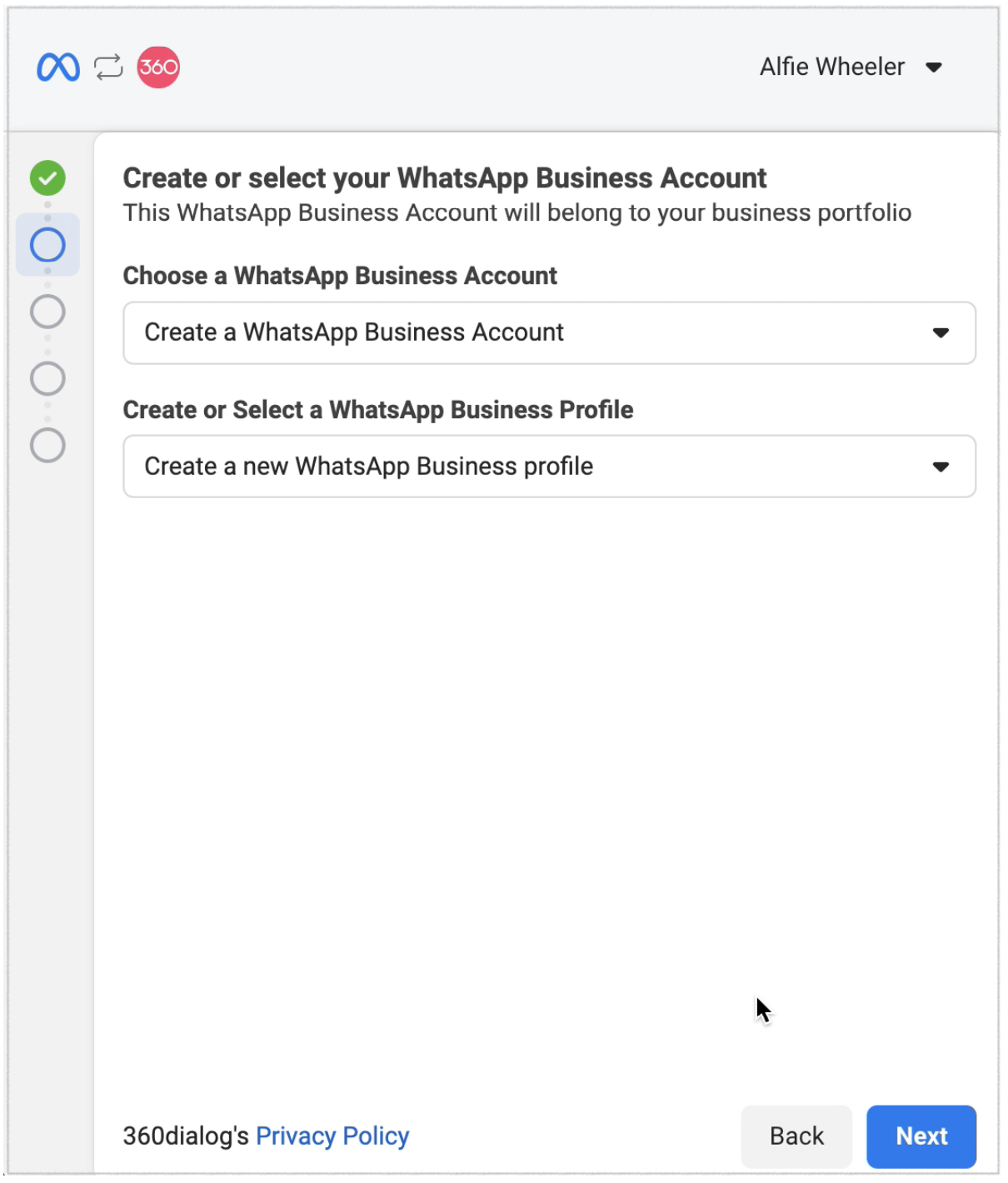
Next, you’ll create your WhatsApp business profile, which will display information about your business to people on WhatsApp. Add a Business Account name and WhatsApp Business display name, and select the category that best describes your business.
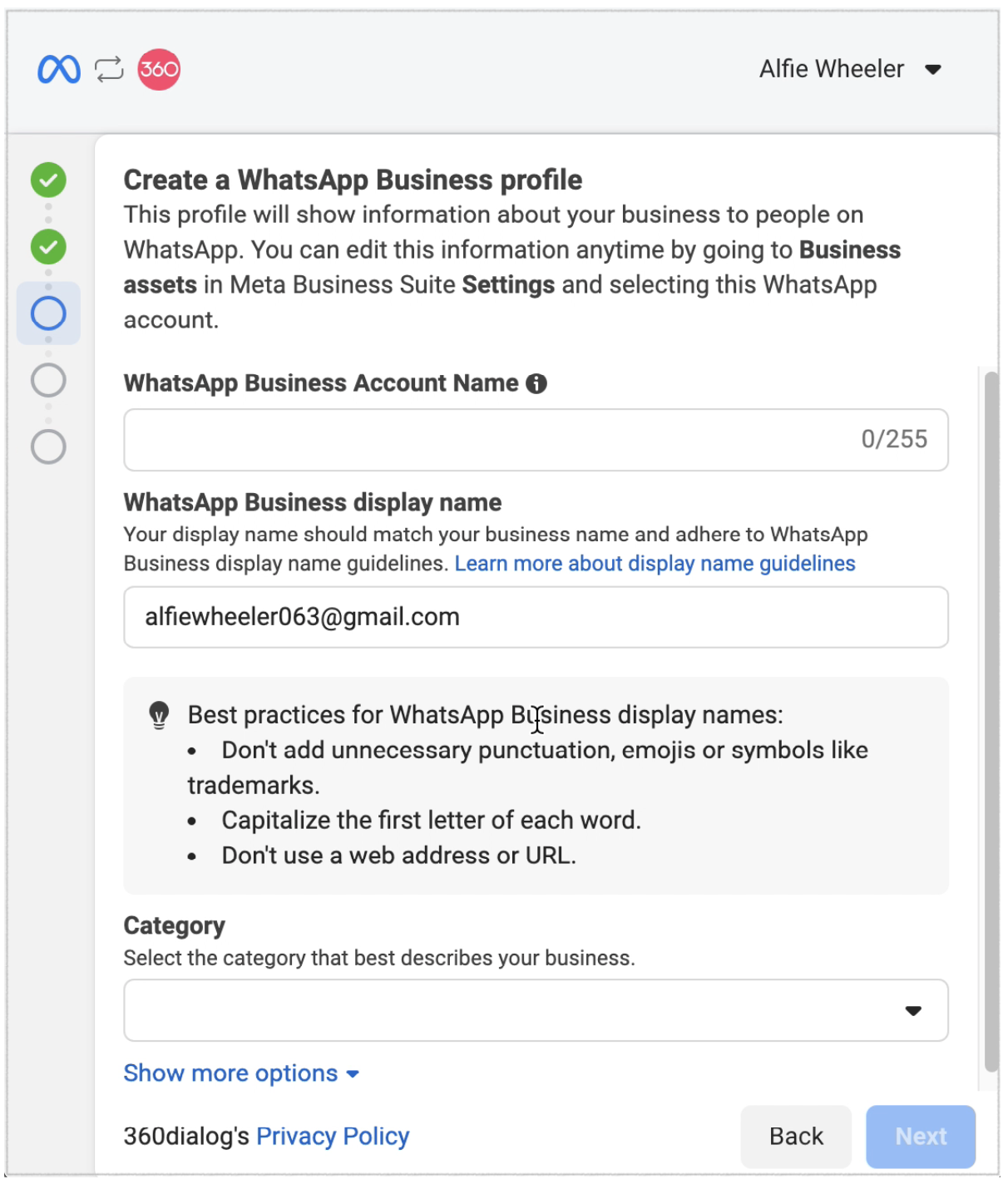
In the next window, you will be required to add a phone number. Please ensure that the number you provide is unique, meaning it has not previously been used on WhatsApp. You can choose how to verify your number (via SMS or phone call) and click the next button.
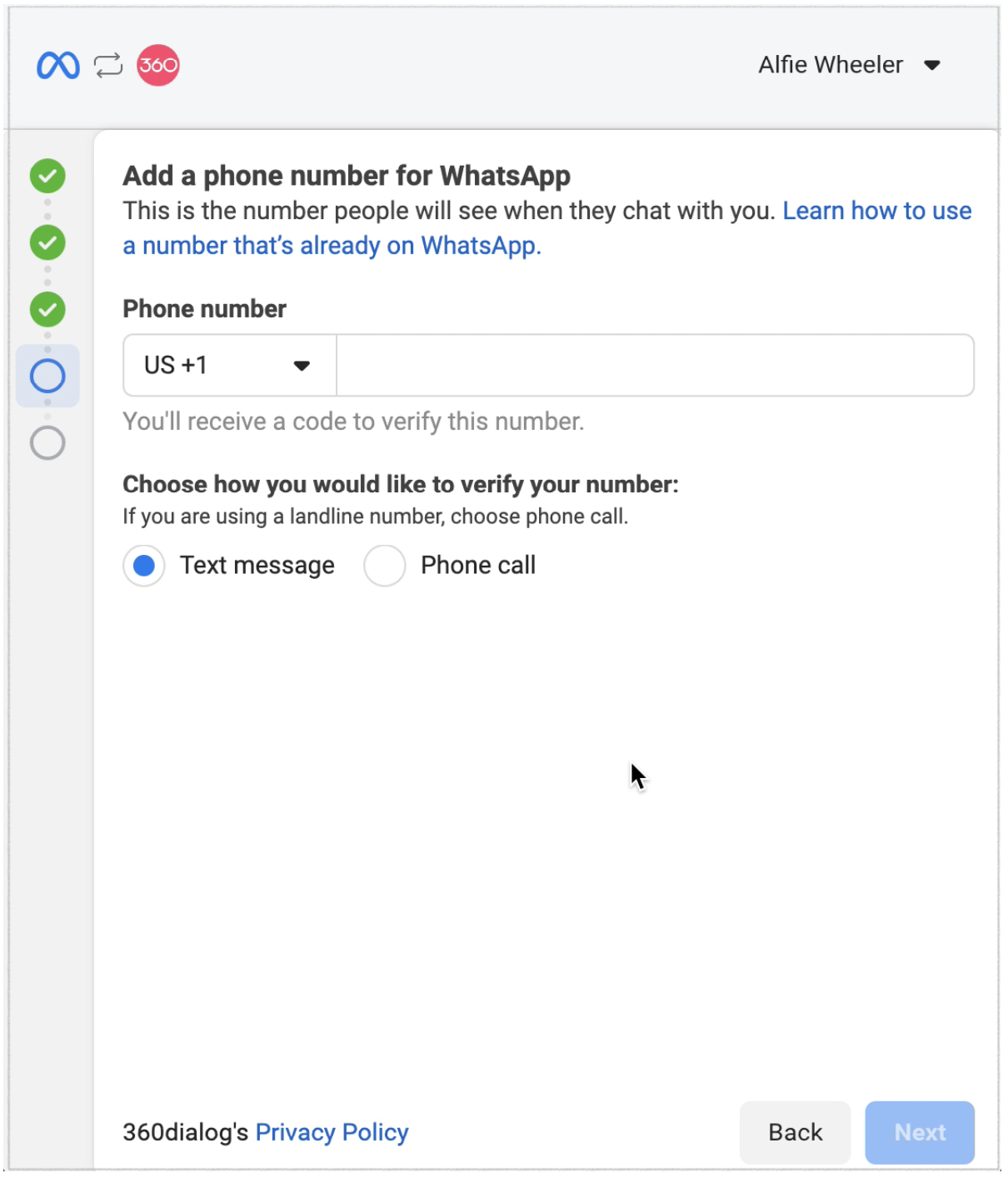
If you already have your number connected to your WhatsApp account and you want to register that same number to your WhatsApp Business Account, please follow the instructions explained on this link.
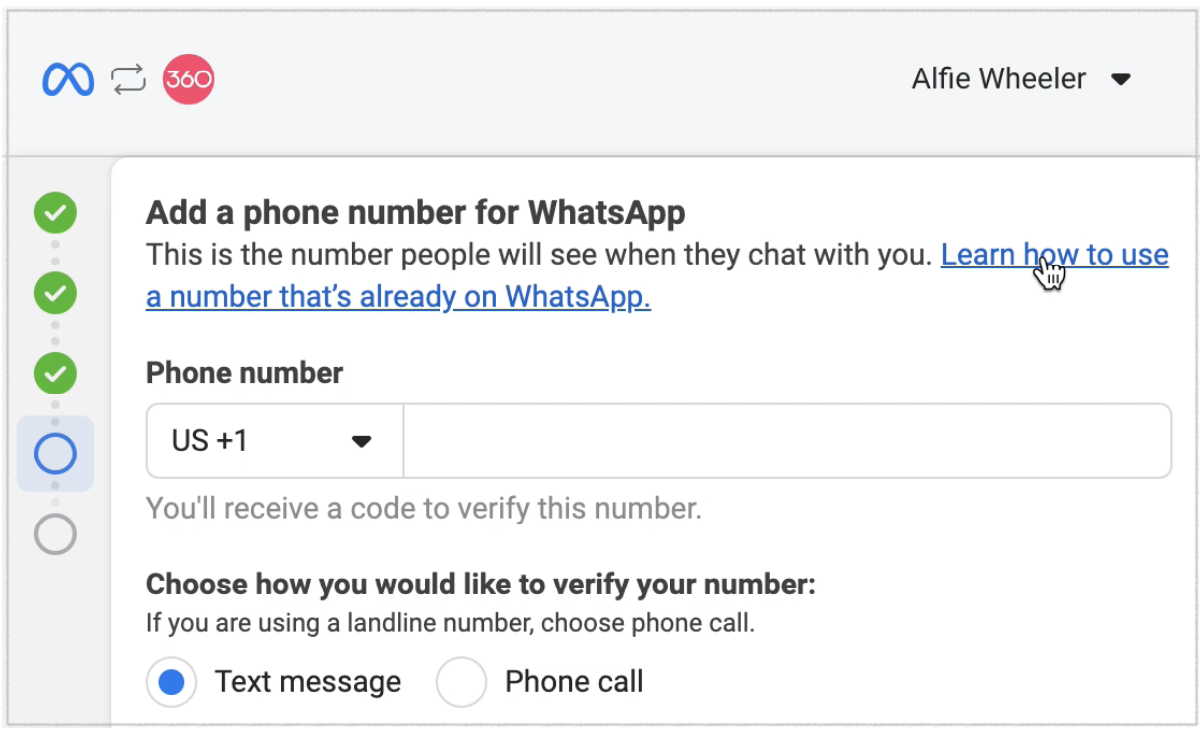
When you choose the verification method, you will receive a code that must be entered to proceed with the process.
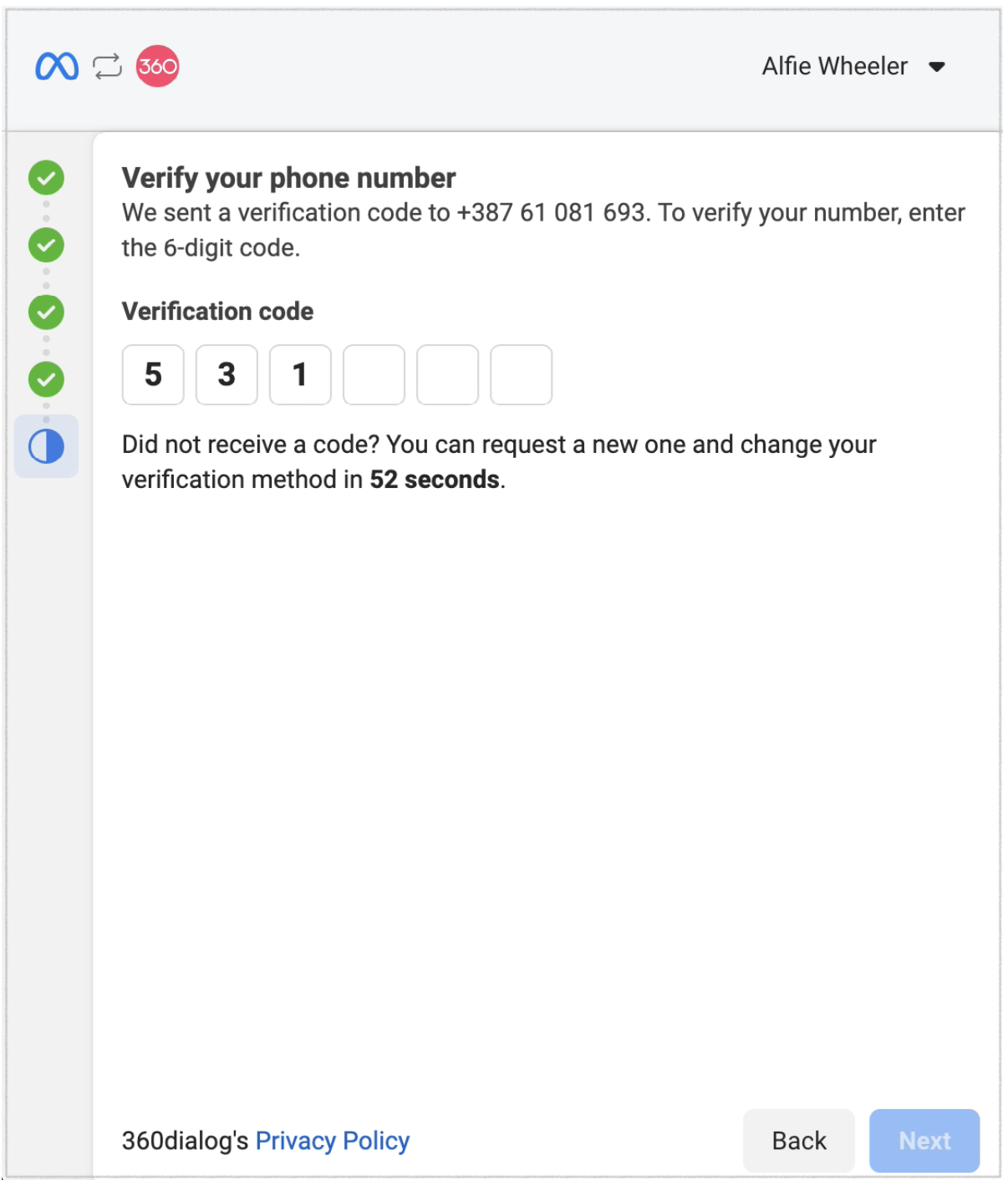
Please keep in mind that you have 60 seconds to enter the code or you will have to repeat the process.
After you confirm the completion of the process, you will need to wait for some time while everything is being set up. If there are too many requests at that moment, you will receive a notification.
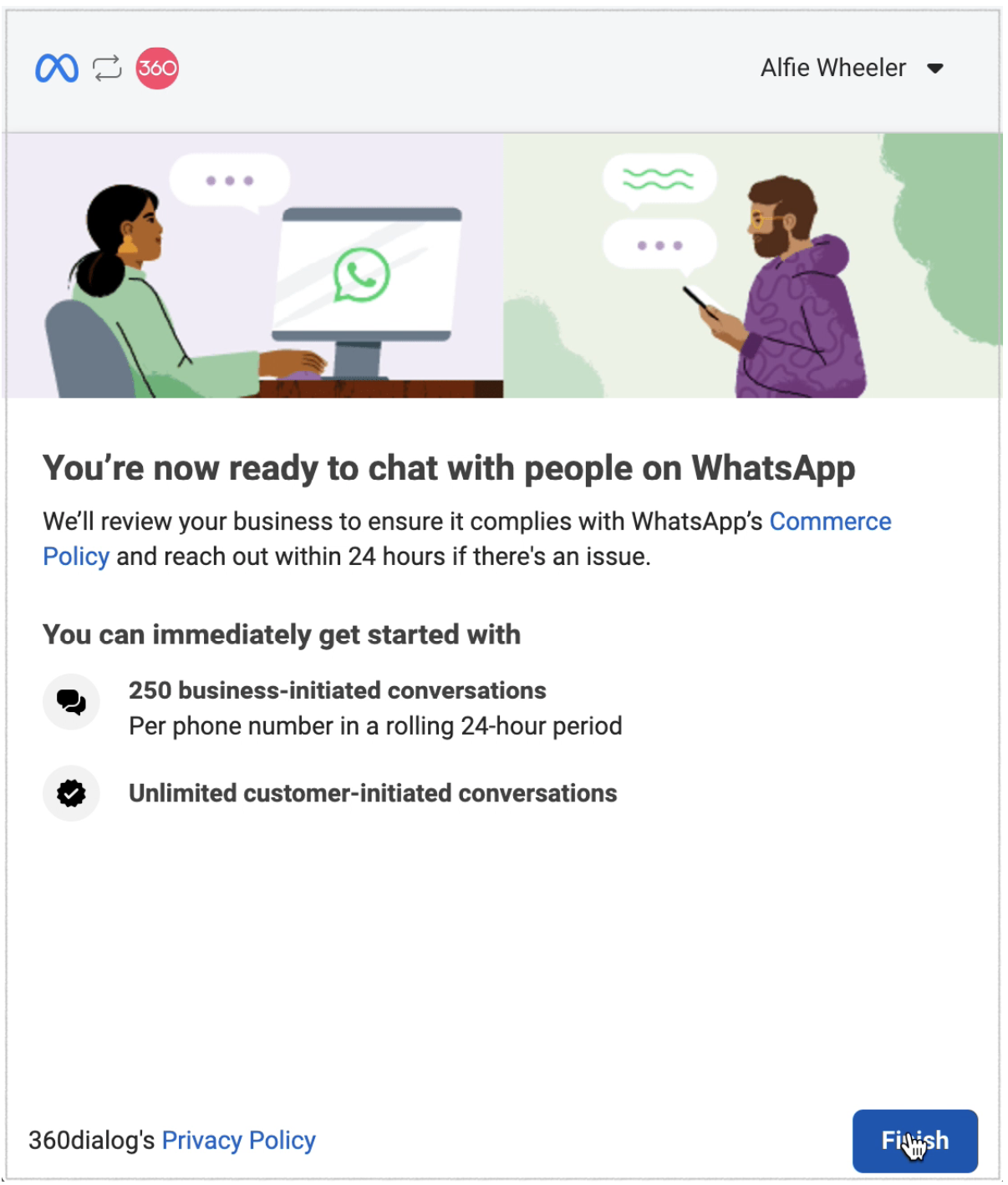
After the setup is completed, you will need to select the numbers you will grant permission to the partner to access WhatsApp Business API. When you select a desired number or numbers, click the Authorize button. Then you’ll be automatically redirected to the CMP window.
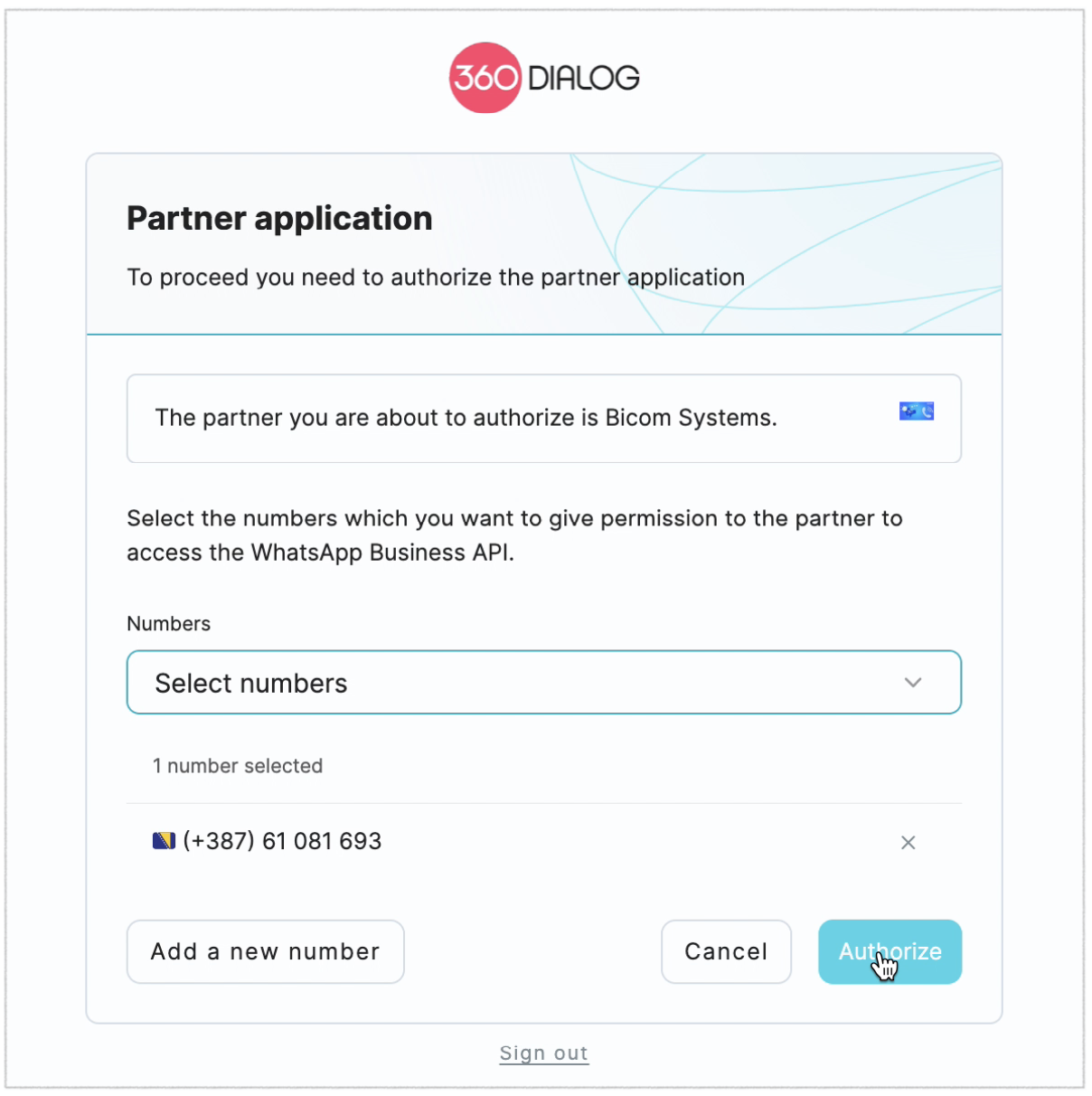
Once you successfully connect via your WhatsApp account, the fields within the new window will be automatically populated. At the end of the setup, the CMP window should resemble the following image:
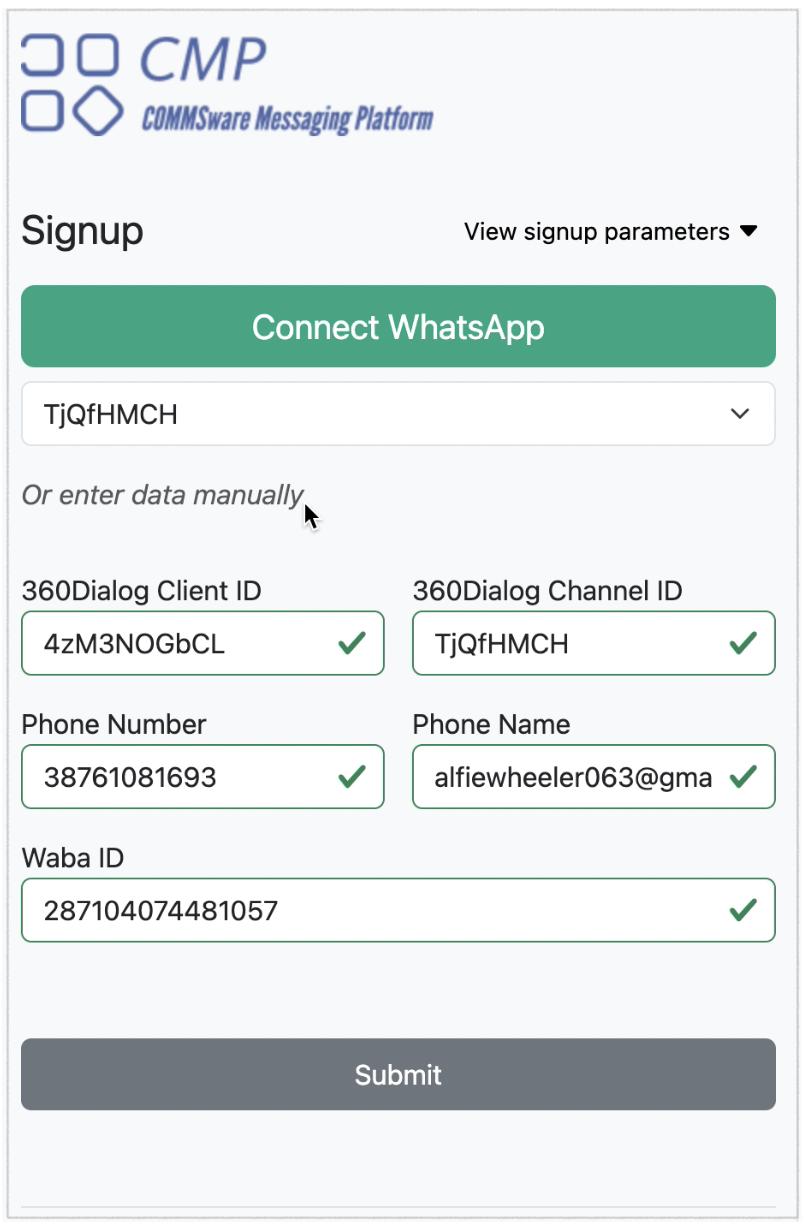
After clicking the "Submit" button, you'll be redirected back to the PBX GUI. From there, you'll need to select the destination queue for WhatsApp channel.
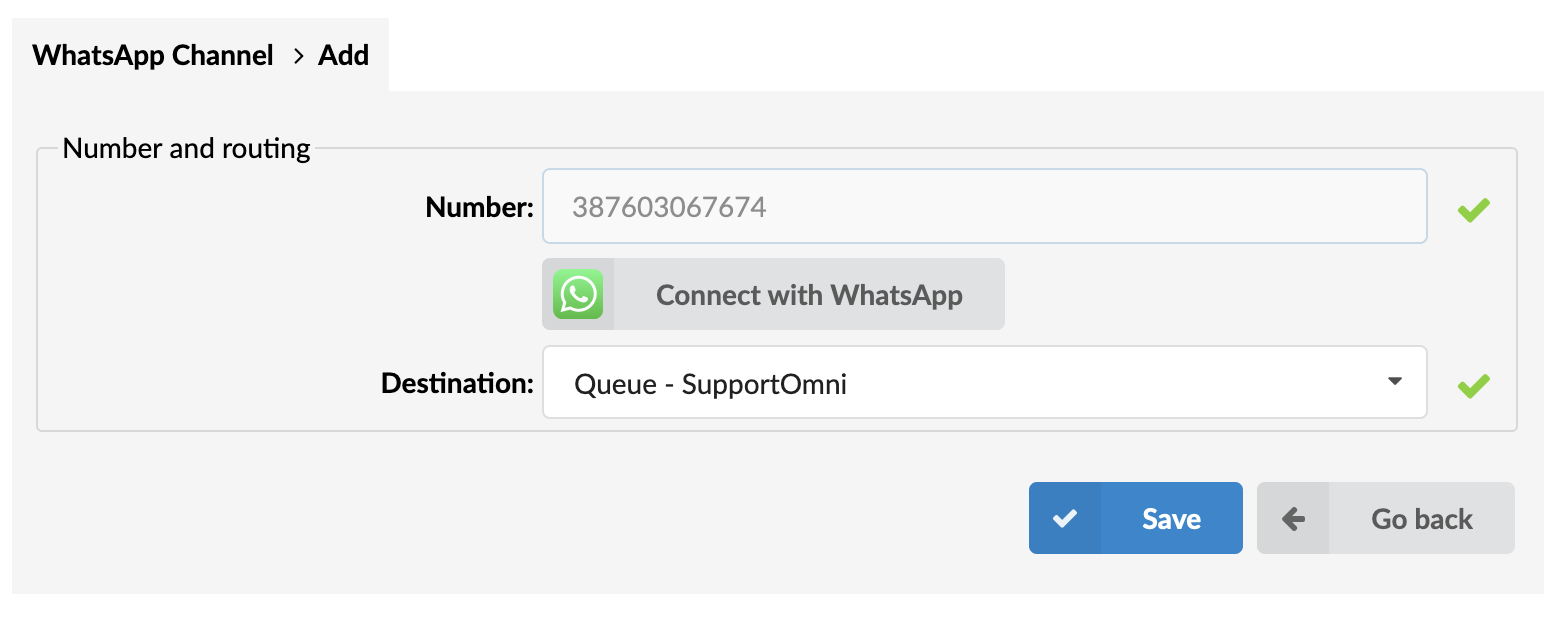
Once you’ve selected the destination queue, click the Save button to save the configuration. This will finalize the setup and ensure incoming messages from the WhatsApp channel are routed to the designated queue within PBXware.
When a user opts to delete their WhatsApp number from PBXware, the following confirmation message will be displayed:
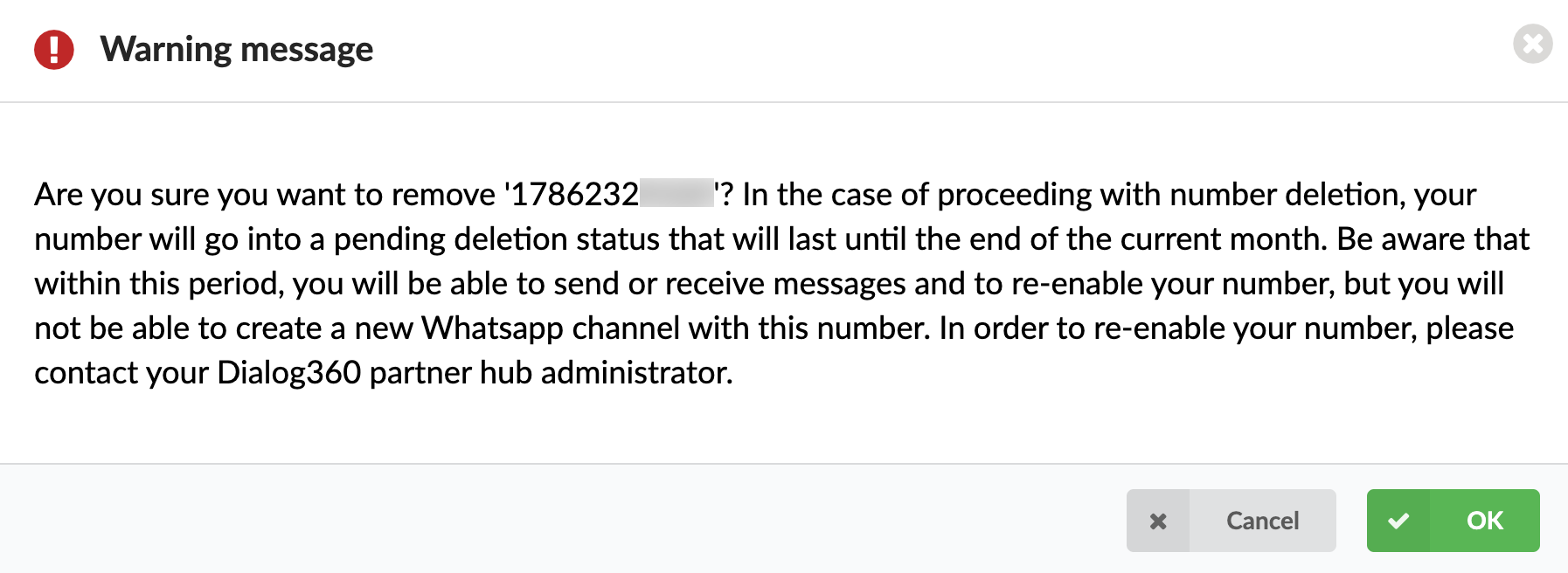
"Are you sure you want to delete the number: +1-786-232-XXXX? In the case of proceeding with number deletion, your number will go into a pending deletion status that will last until the end of the current month. Be aware that within this period, you will be able to send or receive messages and to re-enable your number, but you will not be able to create a new WhatsApp channel with this number. In order to re-enable your number, please contact your Dialog360 partner hub administrator."
Why is this message displayed?
This message is provided to ensure users are fully informed about the specific consequences of deleting a WhatsApp number from PBXware. It highlights the temporary status change, operational capabilities during the pending deletion period, and steps required for reactivation, preventing any confusion and helping users make an informed decision.
¶ Chat Widget
A live chat widget is a small chat interface that can be embedded into a website to provide real-time customer support. It usually appears as a chat bubble or button that can be clicked by customers to initiate a conversation with a support agent. The widget allows for quick and convenient communication between customers and agents, improving the overall customer experience and increasing customer satisfaction.
